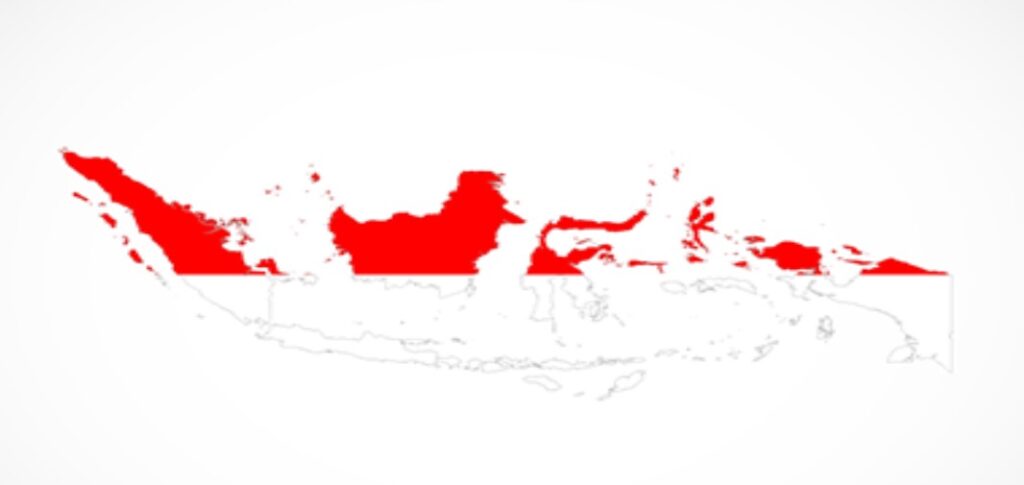
Indonesia is the 14th largest country in the world with an area of a bit over 1.9 million km². It is made up of 17,504 islands.
Indonesia is the 4th most populous country in the world (after India, China and the US) with a population over 277 million. It also has the second largest Muslim population (after Pakistan) with around 86.9%.
So in a former life, I had come to Indonesia a few times. The first was a trip to Bali in the 1990’s and then in 2005 there was a work trip into Jakarta and on to Bandung, in central Java. And when we lived in Perth Jill and I did another trip to Bali.
In addition to this (at the time of writing) the boy and his bride were living in Bali. This gave us the opportunity to have a home base, dump the big bags and do some shorter trips with just the basics. Come back, do the washing, restock and head off again.
Jakarta
The capital is Jakarta with a population of over 11.2 million people. It is the center for business, politics and culture and is serviced by two airports and two seaports.
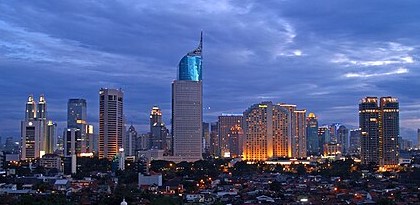
Jakarta is one of those cities that you either love or hate. Those that hate it will recommend not spending too much time here preferring to merely transit the city. While those that love the city will say that you have to experience the city.
What is known is that Jakarta traffic is atrocious. In fact, it has been ranked the 30th most congested city worldwide with the average time needed to travel 10 kilometers in Jakarta is 23 minutes, with an average maximum speed of just 21 kilometers per hour.
My forays into Jakarta were limited and centred more around the embassy than really exploring so I will hold my judgement, other than to say that on first impressions, I would avoid it.
Bali in the 1990’s
The food, drinks and accommodation in Bali are cheap, the scenery is stunning and tranquil, the weather and surf warm and the locals are are smiling and friendly. For these reasons more than a million Aussies flock to Indonesia (mostly Bali and nearby) every year and Australians stay longer in Indonesia than any other tourist – on average more than nine nights.
Having done a scuba course I headed off to Bali to explore some of the options for diving off the Balinese coastline. Even way back then Bali was a nightmare, full of drunken Aussies behaving atrociously. This was particularly bad as I stayed in the heart of Kuta along Jalan Legian. This is ground zero for drunken and poor behaviour, particularly by Aussies.
Quite frankly, Kuta was then, and remains today, a shithole. It is the home of the drunken end of year football trip (but all year round), gridlocked traffic, full of trashy bars, aggressive touts trying to sell you junk. Add to this fake drug dealers in cahoots with crooked local cops trying to get you to buy some weed so they can bust you. Pickpockets that rob you and then hand your empty wallet to the police, who force you to pay a “reward” to the person that robbed you in the first place.
Every year Australians die, are injured, or get sick in Indonesia (again mostly Bali and nearby) with many coming awry of motorbikes, cars, trucks, food, sunburn, monkeys, bad booze, drugs, assaults, theft, and on occasion, terrorists. It is easily among the most dangerous tourism hot spots for Aussies (along with Thailand and the Philippines). Who knows how many others were arrested, detained, jailed or shaken down by police — or worse.
It’s a shithole.
Tulamben Wreck (1990’s)
The main point that I went to was the Tulamben Shipwreck. This is located on the eastern coast of Bali and is the remnants of the USAT Liberty.
The Liberty was a cargo ship that was torpedoed by the Japanese Submarine I-66 in 1941. It was towed in an attempt to reach port but was taking on too much water so was beached on the eastern shore of Bali so that the cargo and fittings could be salvaged. In 1963 volcanic tremors caused it to slip off the beach into its current position.
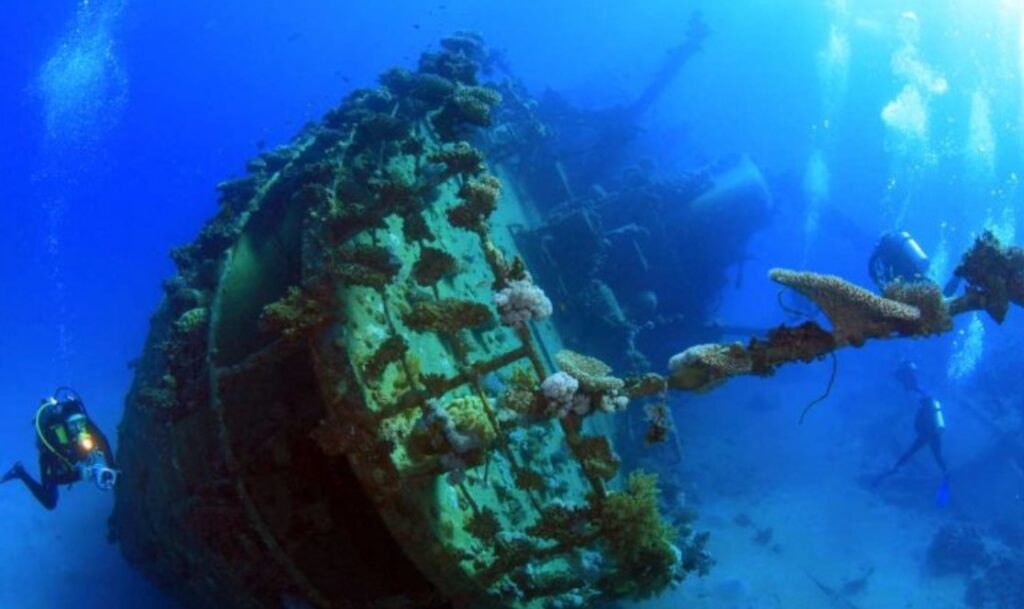
It now lies on a sand slope and provides one of the most popular dive sites off Bali. The ship is 120-m long and lies only 25 m from the shore with a maximum depth of 30 m.
The area has clear water with a mild or no current making the place perfect for diving and snorkelling. When I was there, the shipwreck served as an artificial reef, providing a habitat for a wide variety of marine life. But looking at the images today it has been touristed into oblivion. The wreck, once covered in hard and soft coral, was home to thousands of fish, including schools of colorful tropical fish, eels, and even a few species of shark. The wreck itself was also home to octopus, sea turtles and sometimes even Black Tip Reef Sharks.
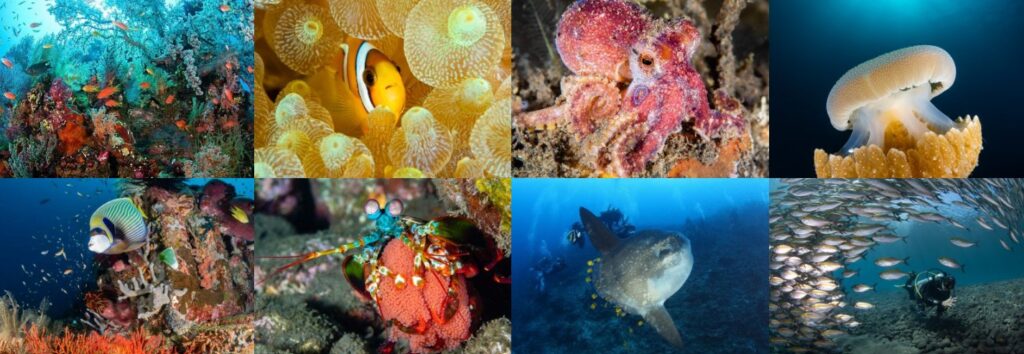
In addition to the wreck there was a coral garden a short walk away. This lay at 2-15 meters depth and was home to many varieties of fish the most notable being the blue-yellow ribbon moray eel.
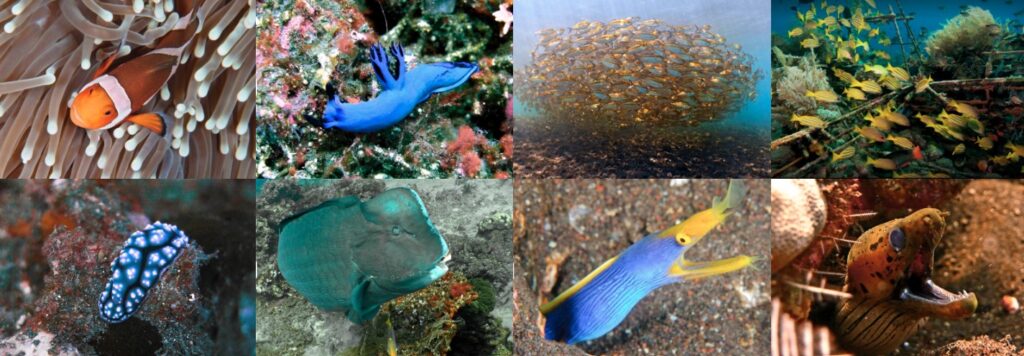
The other thing on offer is the drop-off. This is a 60-70 m wall, formed by the 1963 eruption of Mount Agung. This is a steep underwater cliff that was home to many colorful corals and diverse sea fans. There had formerly been reports of reef and hammerhead sharks sightings.
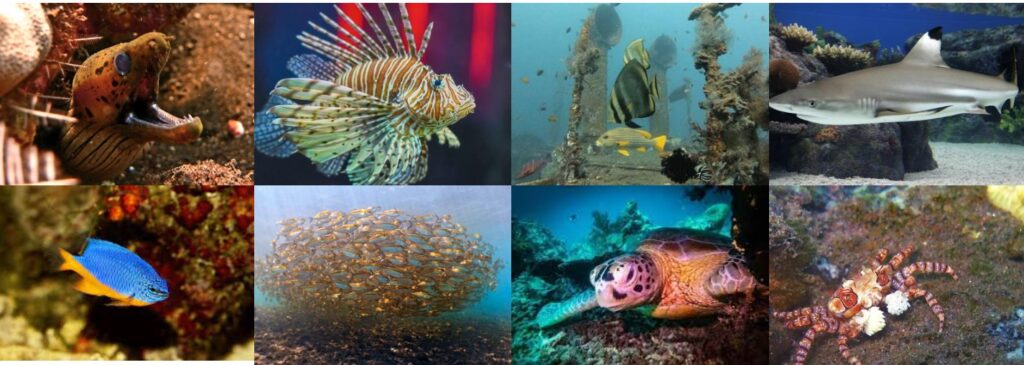
But the 2024 images available from the tour operators show baron fields of trampled and dead coral. A symptom of too many years of tourists and fins scraping the life off the reef. The wreck itself still offers some great viewing for divers and the drop-off is still amazing to see. And of course, in catering for the Instagrammers, they have sunk a bunch of statues for that intimate photo op.



Bandung (2005)
The city of Bandung is the fourth largest city in Indonesia (after Jakarta, Surabaya, and Medan) and has a population of around 2.5 million. The large number of malls and factory outlets has given it a name as a shopping city, and it is developing a name for itself as a culinary destination.
I spent 3 weeks here in early 2005 delivering a training course in the area and doing it tough living at the Hyatt Hotel the whole time.
The city is surrounded by mountains and broadly resembles a bowl. The most prominent of these mountains is Tangkuban Perahu which is an active volcano, situated 30 km north of the city. It is the only volcanic mountain in Indonesia that you can drive up to its outer rim.
When I was there I headed up to the volcano on the Sunday and was woken on the Monday morning to the sounds of alarms.
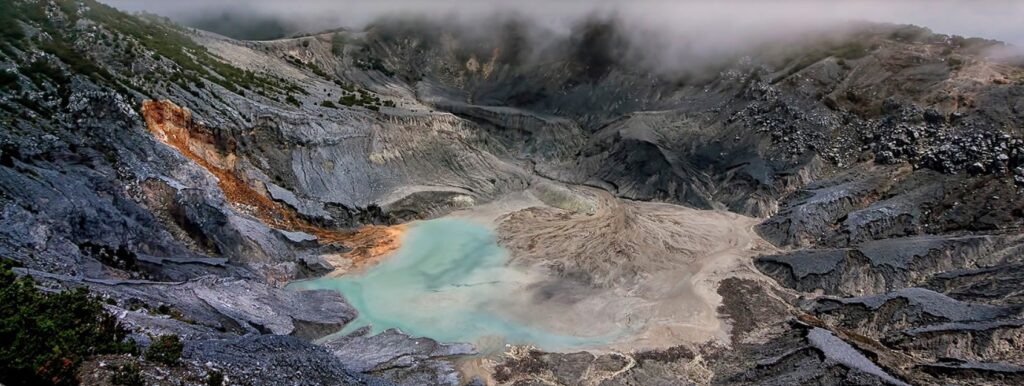
From my window at the Hyatt Hotel, I could see that the top of the mountain (where I was the day before) had blown and toxic gases were spewing forth. Watching the news I found out that the Directorate of Volcanology and Geological Hazard Mitigation raised an alert, forbidding visitors from going up the volcano. “Sensors on the slopes had picked up an increase in volcanic activity and a build-up of gases.
Then on 2 August 2019, the volcano experienced eight minor eruptions, and as a result, was closed down for visitors, but is open again.
A bit of Island Hopping (2024)
Having arrived in Bali and caught up with the boy and his bride, they promptly abandoned us and flew off to Singapore (that work thing tends to get in the way). So with a ready place to use as our base, we dumped the big bags and started making plans to do some island hopping through some of the 17,500 islands in Indonesia.
The island of Flores
Our first port of call was on the western tip of the Island of Flores which is where you will find the town of Labuan Bajo. What was once just a small fishing site, has become the main gateway to the many exotic destinations in East Nusa Tenggara. The reality of this (and the whole reason we bothered) is that Labuan Bajo is the launching point to go and see the Komodo Dragons.

A quick one hour flight from Bali to the Komodo International Airport, which is on Labuan Bajo, as the actual island of Komodo is a national park. So Labuan Bajo serves as the gateway to get to both Komodo and Rinca Islands, where the dragons can be found.

So we settled into our very nice accommodation, organised our full day adventure for the next day and prepped for what was sure to be a huge adventure.
Padar Island
Padar Island is a small island within the Komodo National Park, located between Komodo and Rinca islands. It is the island that did not have any of the Komodo Dragons but does have some pretty spectacular landscapes and an Instagram worthy lookout. While the dragons were suspected to be extinct on the island, recent surveys have found 12 of them on the island.
The island is rugged, with steep volcanic mountains and hills and four deep bays. These bays predominantly have white sand beaches however some have grey and pink sands. The reality of the stop here was for the Instagrammers to get their amazing landscape selfies.
But you had to work for it.
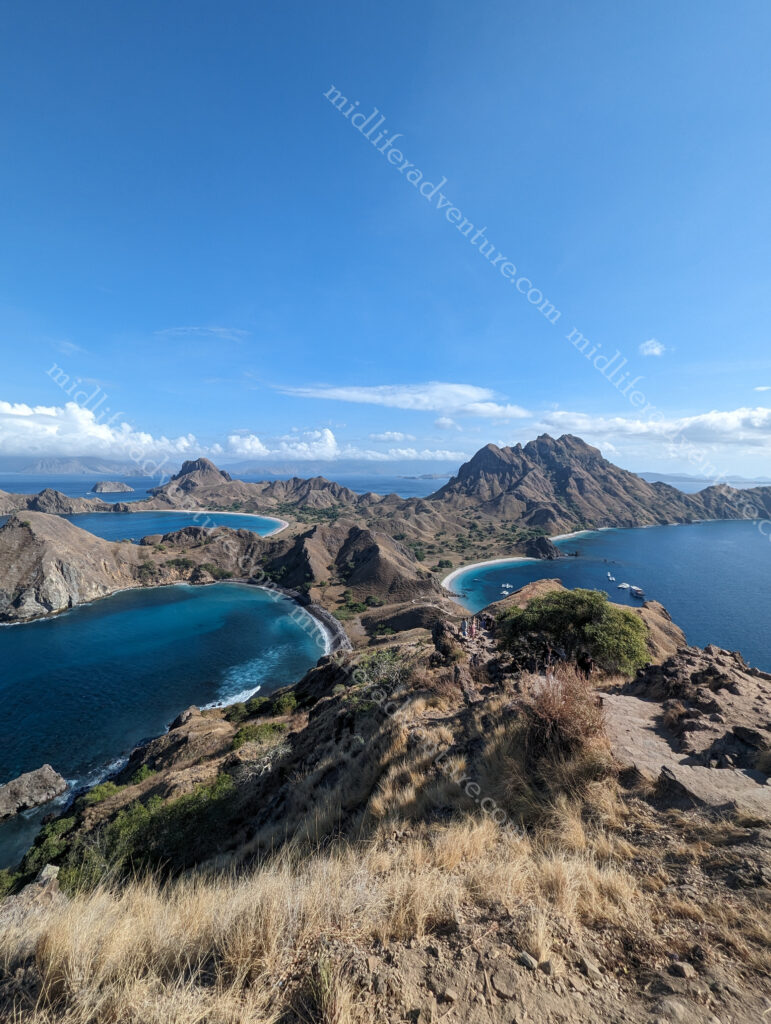
You get dropped off at sea level and pay your park entrance fee, from here it is all uphill for the magic photos. And it is seriously steep and has a ton of non-standard monster stairs that you need to climb to get to the top (where the amazing views were). I did the first few hundred stairs (up to photo point number 2) and looked at the rest and thought F this. So I sat in the sun (there is zero shade) and marvelled at my bride who willed herself (albeit slowly) up the remaining 500+ stairs to the top.





From up the top she got some amazing views of the island and the various bays and beaches. But then she had to come back down. It must be said, after the first 10 meters, there is nothing. No drinks, no shade, just stairs and lots of them. And they are dodgy as all get out. One step may be 10cm while the next will be 60cm and the next anywhere in between. This means that there is no pattern that you can get into and that every step is a lottery.
And coming down is even more of a challenge.
Having done the lookout Instagram thing, it was back on the boat where you could finally get a cold drink. And the cold drink that they handed us was Pocari Sweat.
This is a well known Japanese sports drink.
But neither Jill nor I were too keen to ingest something called sweat.
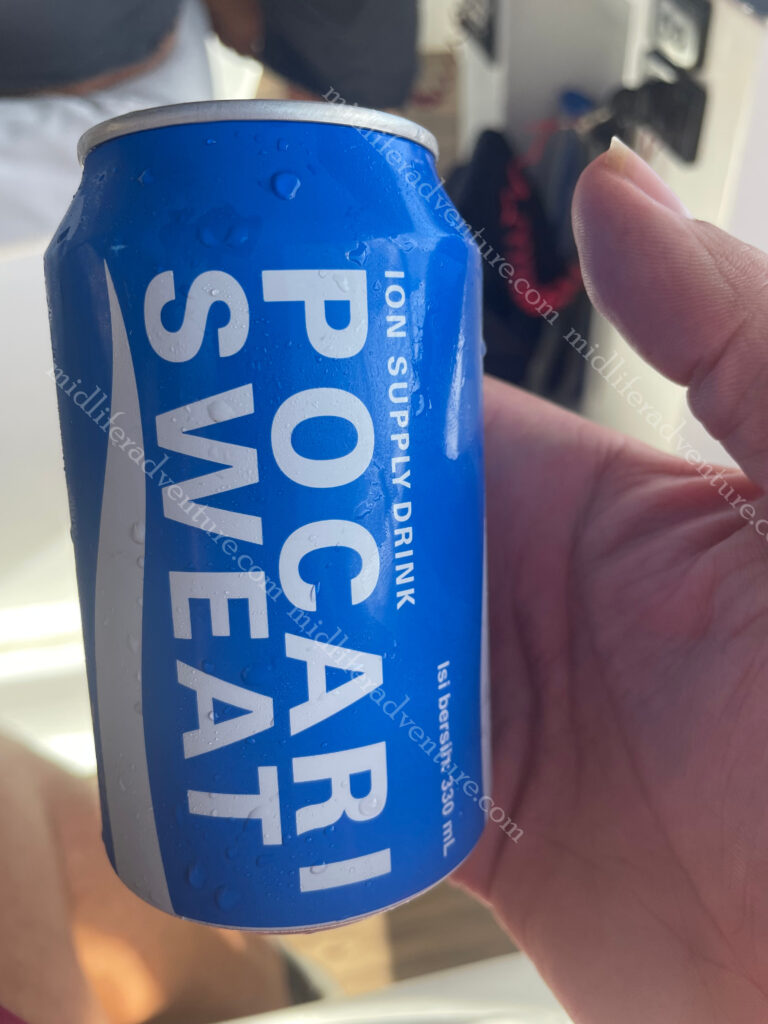
We had one and it tasted a bit lemony, but the name precluded us from having any more and we settled for water from then on. So on the boat, we bounced around the island to one of the bays (particularly one of the ones with pink sand) cleverly named Pink Beach.







And believe it or not, the sand is actually pink. Pink Beach gets its colour from the crushed shells of millions of microscopic bright pink sea creatures called foraminifera.
Komodo Island
Next stop was the main attraction, Komodo Island. This has an area of 291 square kilometres, and a human population of about 1,800.



Komodo Dragons (Varanus komodoensis) or Ora as they are locally called are survivors from the Jurassic period.
It is the largest species of lizard, growing to a maximum length of 3 m, and weighing up to 70 kg.
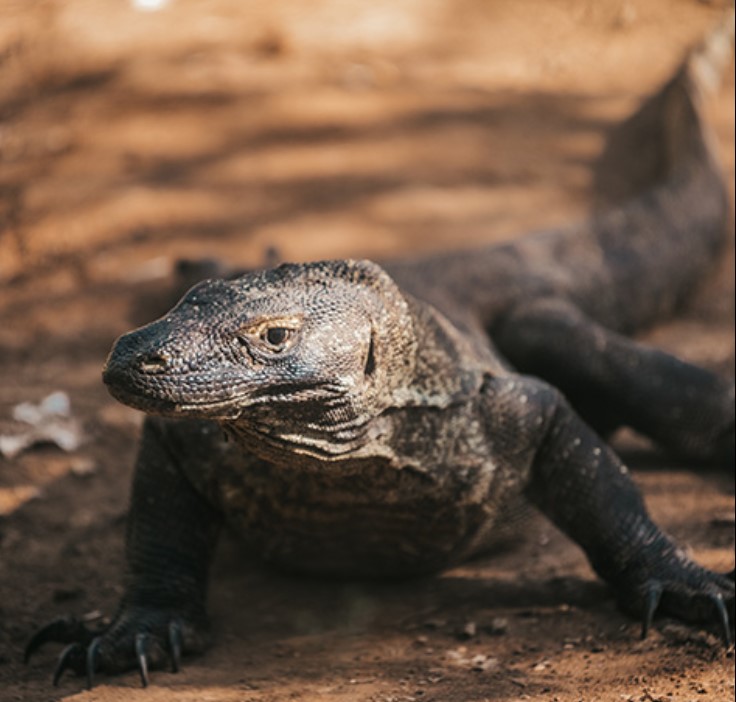
Seeing the Komodo dragon has been on my list of things to do since seeing an old James Bond movie (Skyfall I think). Being Australian, I have seen some big goanas and in Thailand we saw some almost 2 meter water monitor lizards, but the Komodo Dragon is the big dog in this fight.
And we got lucky.
We had heard stories that they tend to overfeed the big ones so that they stay about the main area to guarantee a sighting. But we had met people at our accommodation who had gone the day before and saw only little ones.
Our first encounter was a baby (about 30 cm long) that scuttled up a tree and impressed absolutely no one.
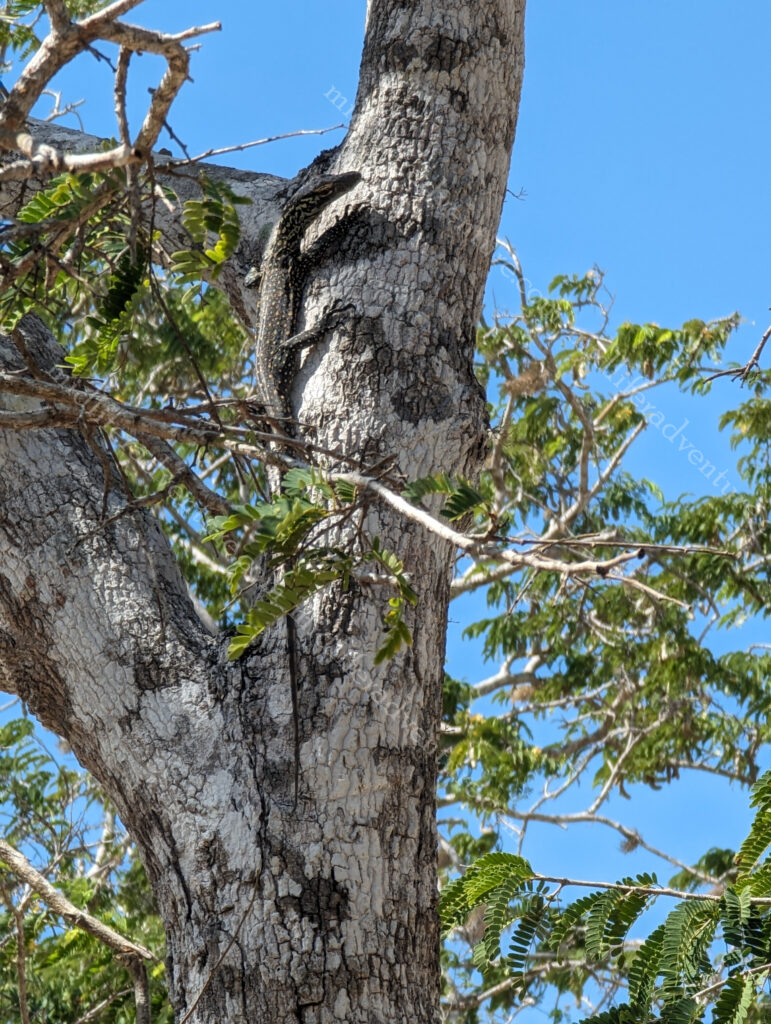
We then saw a juvenile one about 2 meters long under a tree by the beach and then we saw the big 3 meter monster. This one fit the bill of the overfeeding type. It was massive, but it was also in a food coma under a tree, virtually incapable of moving more than to raise its head and look about a bit.









And then we hit the real mother lode. A huge dragon (over 2.5 meters), that had not been overfed and incapable of movement. This was an adult dragon that was walking and stalking about, and that was (quite frankly) a terrifying sight to behold (exactly the experience that I was after). I really wanted to get a sense of just how imposing these bad boys would be to meet in the wild.
And this one certainly delivered this.
Once he settled down a bit, it was time for photos.
Being good guides, they are masters of getting the good photo and they know how to line it all up to look the most impressive.
So based upon that, I got my Instagram shot that looks like I am patting a huge lizard.
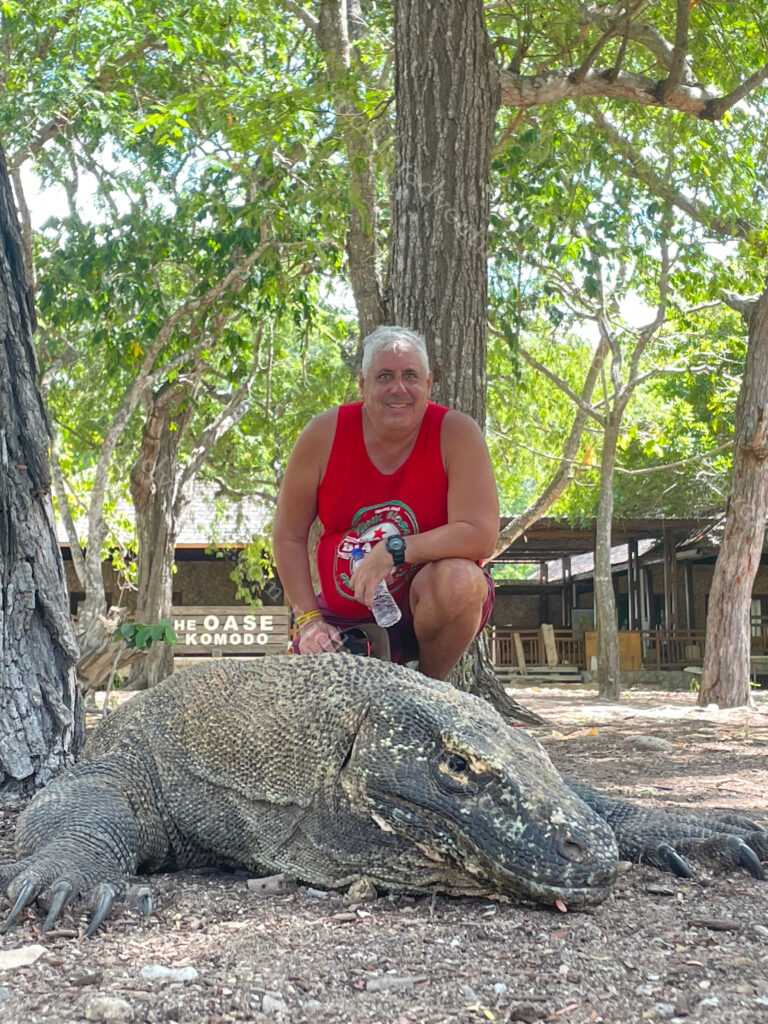
In reality I was at least 2 meters behind him with my hand raised as if I was petting him. Neither I nor the guides are stupid enough to actually pet (or let me pet) one of these monsters. But the photo looks good.






In checking them out I found out that their main food source is the Javan rusa. This meant nothing to me until I googled it and found it to be a full grown deer over 6 foot long and weighing around 160kgs. As it happened, we were also lucky enough to see about 6 of these as we trekked through the Komodo jungle.


While the majority of us in the group were amazed at actually seeing wild deer up close and personal, the American in the group was lamenting the fact that he did not have his gun to shoot these majestic animals. The dragons hunt and ambush prey individually but have also been known to hunt in packs when required. Their saliva contains both a poison and bacteria that lead to death.
So once a Komodo dragon bites a rusa (deer) it then follows it about for 3-4 days until it dies. If a human is bitten, you have 5 hours to get a fast boat to Labuan Bajo to get the antivenom (cos of course they don’t have any on the island where all the dragons are). If you miss the 5 hr window, you will lose that limb. You then have another 3 hours, and if you miss that, then there is no point in giving it to you as you will be dead in 3-4 days, just like the deer.
Taka Makasar
According to the blurb, the sensation of enjoying a tourist destination in Komodo National Park will not feel complete if you don’t stop at Taka Makassar, a piece of a lost island that appears there. This island is the size of a football field in Komodo National Park will only be visible at low tide.
When the sea water recedes, the island appears in the form of a stretch of white sand surrounded by blue sea.


So our boat (along with every other damn boat) stopped there so that we could be buffeted by waves to walk on a sand bank and then do the whole lot in reverse.
Kanawa Island
The island of Kanawa is only 15 km from Labuan Bajo and is renowned for being fringed with coral reefs teeming with colorful fish all around. The turquoise water is calm and clear making it the perfect swimming and snorkeling stop on our island hopping tour.
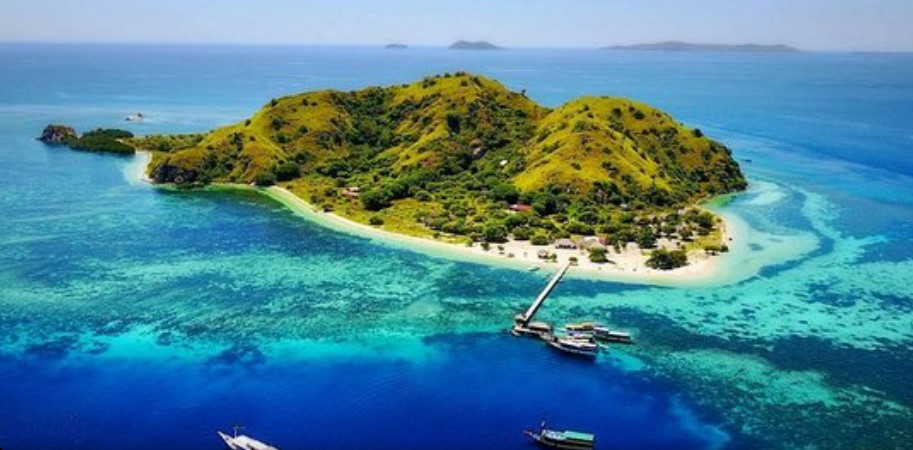
The island itself covers only 32 hectares with two bulging hills offering fantastic panoramic views. There is nothing really to do on the island, except to take in everything that the water has to offer.
Sadly the coral was flogged. Tons of clumsy tourists stomping all over everything has pretty much made this a dud stop. The island is pretty and the water is clear, there are still some fish about, but as a snorkelling destination, most people passed.
Day over and we were back at Labuan Bajo for some well earned rest.

Having ticked the major Komodo Dragon box for me we decided to take the slow route back to Bali, taking in some of the lesser-known and less touristy places. This meant that rather than hopping a one hour flight from Labuan Bajo we would hop a ferry (many of them in fact) and bounce from island to island on our way back in the general direction of Bali.
So the first thing was to get a ferry. This led to some very strange looks from people as nobody did this. Why would you go to nowhere places, when you can be back to relative civilisation within an hour’s flight. But they weren’t married to Jill, who wanted the adventure. So we moved from our nice hotel to one that was closer to the shoreline (still pretty nice).



Sumbawa Island
We hunted down the ticket office and worked out that for $10 we could invest ten hours on a local ferry that would take us over to the island of Sumbawa and and more specifically the town of Sape. Given that we would be in for the long haul we sprung for the extra $2.50 to upgrade to first class tickets and settled into the air conditioned comfort of the lounge – such as it was.
Sape
After our ten hour journey we arrived on the dock of Sape which is a small fishing village in the far east of Sumbawa. The main claim to fame is as the cheap way (used by the locals) to get to Komodo Island and neighboring Flores. The town consists of a fishing village and a nearby harbor. And not much else.
Jill in doing her research on where to stay found that the usual (hotel booking) websites had absolutely nothing on offer in Sape. But as we would be coming in late, after a lengthy commute, she hunted hard and found us a bed for the night. The alternative was to continue our journey for a 2 hour road trip on highly suspect roads at night to get to the other side of the island.
Having found a place (god knows how or where) we found it was about a kilometer walk from the ferry. So we chose to walk, avoiding the numerous touts offering lifts to the opposite side of the island (because nobody stayed here).
Possibly the only two westerners to have ever walked the streets of the town, we were quite the novelty, especially to the children. As we walked we had large swarms of kids saying hello and god knows what else in their own language.





Our accommodation was acceptable and we managed to get what passed as a meal. Getting a beer however proved far more difficult. In Bali you can get a large (620ml) beer for about $3.90 here it was $8.20 and had to be ordered in specially. Then they passed on the transportation costs (another $2), and after all of that, the beers were hot.

The town did not have the usual issue of stray dogs roaming the streets, rather, it had the issue of stray goats.
Long, floppy eared goats.
And they were everywhere, off leash, darting in front of cars and motorbikes and eating virtually everything in sight.
Some were housed in little roadside shelters, but for the most part, they were free range.
The next morning it was up and out. The hotel manager would organise a ride for us but at a highly inflated price. Having been inundated with offers of a ride the night before, we figured that the same would be true the next morning. How wrong we were.
About 500 meters from our hotel was the major crossroads between the town and the dock. We figured if we went down to there, everyone would go past, and we would be flooded with offers to get a ride (the two hours) to the other side of the island, to the town of Bima.
So we wandered down to the intersection.
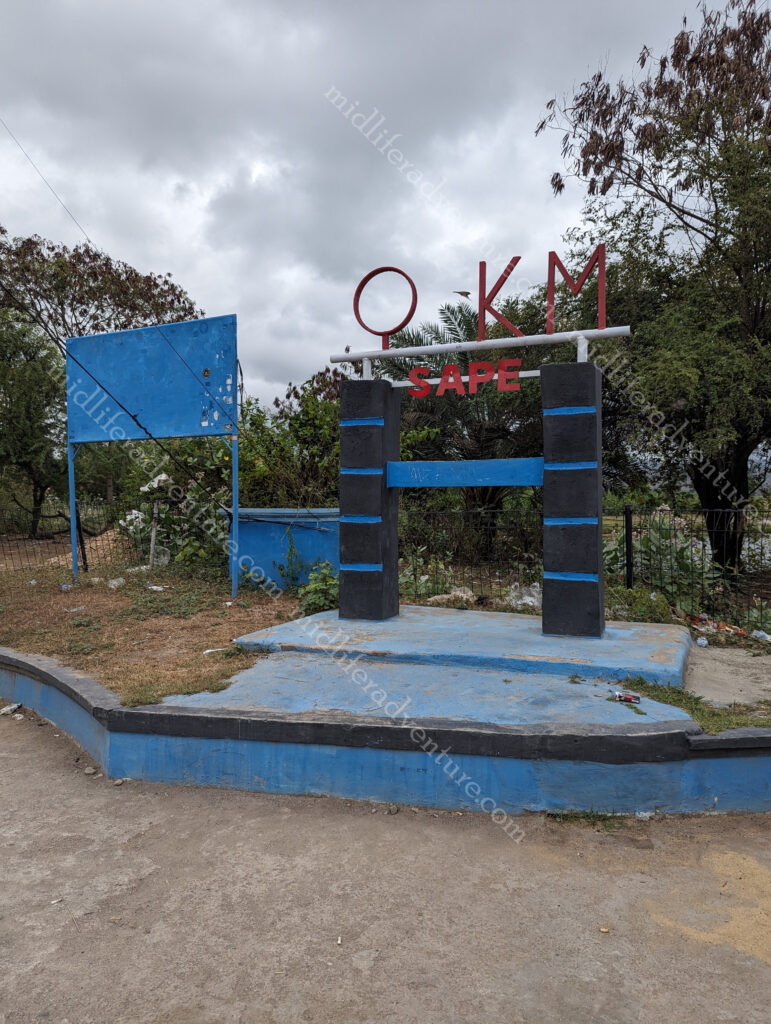
On the way, we were once again local superstars, especially among the school children who greeted us, waved, smiled, high fived, and fist bumped us every step of the way. Having milled about at the intersection for a bit, there were no offers of transportation, and no obvious sign that there would be any. The night before we had seen (god bless google maps) that the local bus station was to the right, so we figured we would walk in that direction while we waited for our ride.
As we wandered a local lady stopped her motorbike (with her son on the back) so that her son could say hello, practice his English and introduce himself to us (as well as shake our hands). Did I mention that we were quickly becoming the talk of the town. When she found out we were headed to the bus station she looked mortified. Saying “no too far, too far”.
She then rode off, stopped a few hundred meters up the road and handed her phone to me, when we caught up again. It was her brother, who spoke better English, who proceeded to tell me that we were over 5km from the bus station and that it was a very long walk in the heat. I thanked him, and her, and the son and took the hint.
At this point I hailed down a ute, that seemed to pass as the local taxis. Asked for a lift to the bus station (Terminal Bis), he nodded and Jill and I hopped in the back of his ute. The back of the ute was filled with fish from the harbour, and what I hailed down was not a local taxi, but rather just some dude on his way back fro mthe fish market. Anyway, we had successfully hitchhiked and he happily drove us to the Bus station. Jill sat perched on a polystyrene box full of fish while I stood on the back, ducking low lying branches every time we passed a tree.
Now if we were the talk of the town before, the sight of Jill sitting amid the fish and some big monster ducking trees as he perched high above this ute, really sealed our fate. I am certain that our visit will be talked about for a while to come.
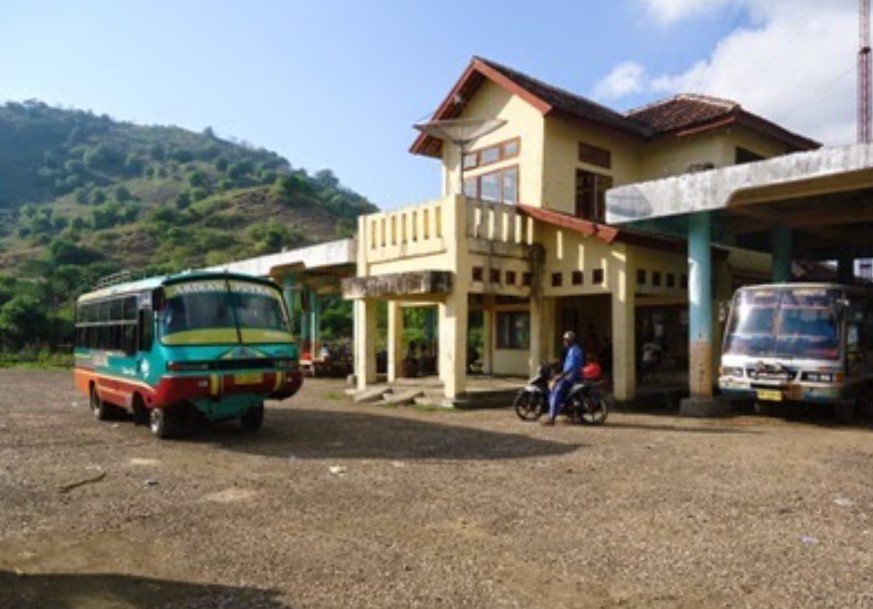
Our mate (as it happened) was not a local taxi, just a bloke willing to help out. So we flinged him $5 and thanked him greatly as we got off at the Terminal Bis.
The bus station was hovel in the middle of nowhere, with some of the shittiest buses that you have ever seen. We negotiated our tickets (at seemingly highly inflated westerner prices) and got on the dodgiest bus that either of us had ever ridden in (which after India is really saying something). We sat in the back seat, the door next to me would not close and within the first five minutes we had blown a tyre.







We passed the true version of rural Indonesian life. There was corn drying by the roadside, every type of landscape that you could imagine and of course roaming gangs of monkeys (tree rats). All of this highly visible and accessible through my open door.
At one point we even passed a truck that had fallen off the side of the road and was laying on its side in the gutter.
There was a crowd of people scratching their heads about what to do about this.
But it reassured us that the idea of staying the night in Sape was a good one, rather than try to negotiate that road at night.
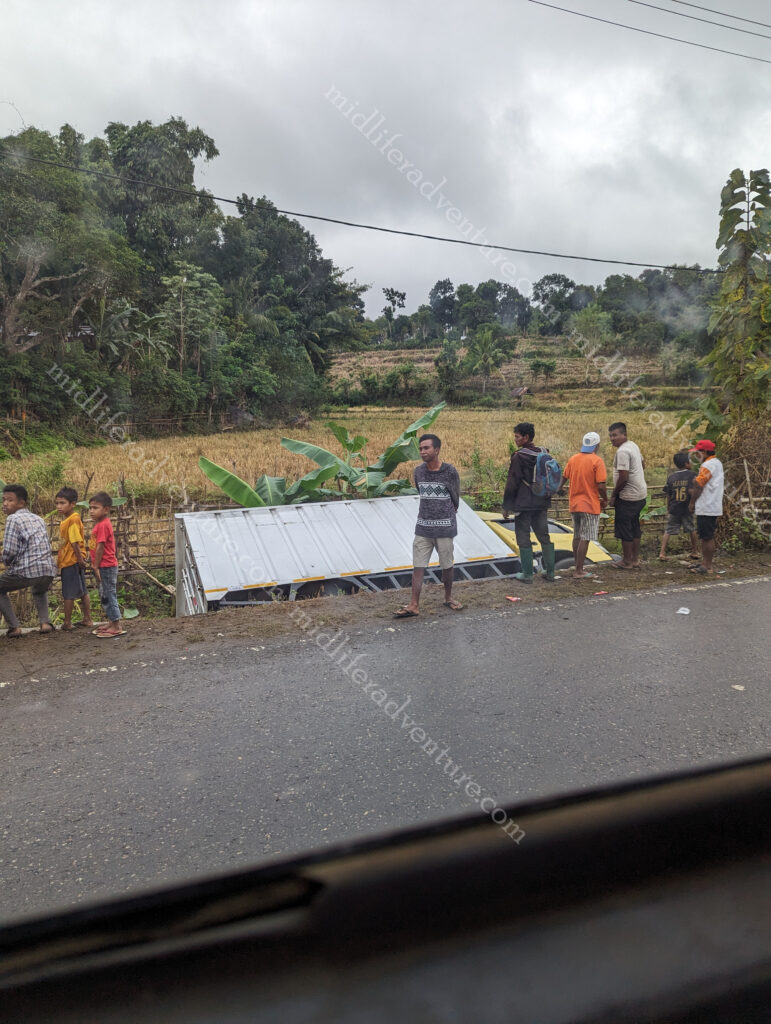
At one point it was time to pay. So the driver came around to get the money and the exorbitant Westerner rate they had quoted disappeared and he only took $5 for the both of us. Whether this was a miscommunication or a burst of conscience, but we travelled the 2 hours across the island for $5.
Bima
Bima was the big town (about 150,000) on Sumbawa and was the home of the airport that would get us out of here and back to something resembling civilisation. But first we would poke about, have a look and spend the night. Needless to say that our bus ride dropped us at a similarly dodgy bus terminal at the other end of the island.
Thankfully Grab worked here (which it did not do in Sape) and we were able to get a car to the hotel that we were booked into. The alternative was that Jill and I would sit pillion on a scooter each while they drove us the 14km, up the steep hill, with our bags to where we would stay. But first we would have to hear all of the touts telling us that no car would come for us and that the only option was the bikes. This continued right up to when the car arrived.
Having got to our hotel we then found that it did not serve food, and that there was nothing within about 5km of us. We decided to order food from the Grab app and have it delivered. This was able to be achieved simply and seamlessly.
Our foray into the less touristy areas of Indonesia was highly enlightening for us. While it is manageable it is quite challenging once you get off the beaten path. Too many tourists is not great, but you do still need enough so that you are not a curiosity having to hitch hike in the back of fish trucks.
Lombok
Lombok is east of Bali and west of Sumbawa and is part of the Lesser Sunda Island chain.
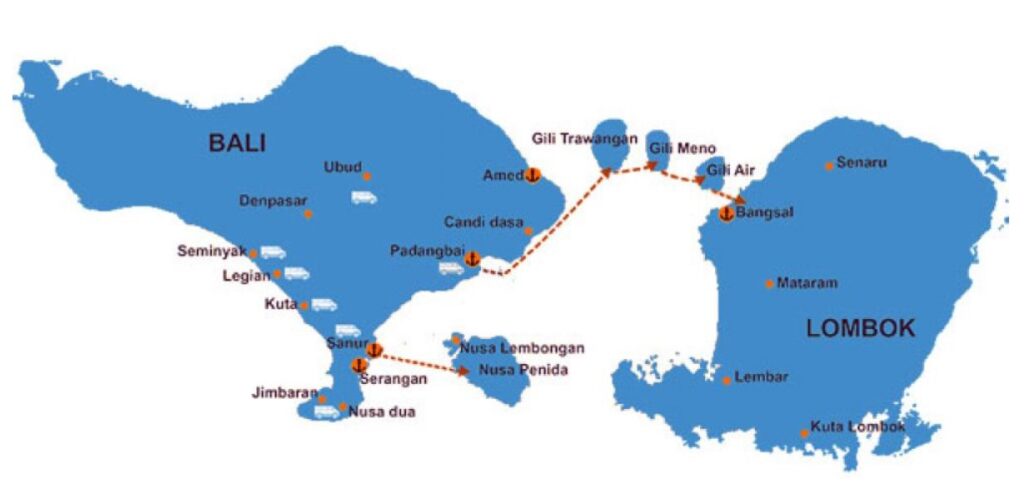
It’s known for beaches and surfing spots, and was somewhere that I had visited, way back when. Our time in Lombok was really more about relaxing rather than racing about to see things. Jill had us booked into a lovely hotel, so when the rain started, we just kicked back and enjoyed some quiet time.






If we had been more motivated, Lombok does offer a fair old range of sights to see. Nothing startling, but the usual mix of Indonesian style attractions, tons of beaches, snorkelling, volcanos. trekking, waterfalls and rice terraces etc.
But our interest, and the reason for coming, lay in the Gili Islands.
The Gili Islands
The Gili Islands (the word “Gili” means “small island”) are a trio of islands off the northwest coast of Lombok. All share similar traits but each has its own style and character. They are all fringed by white sand beaches and all have banned motorised transport. This gives you a small respite from the usual Indonesian traffic.
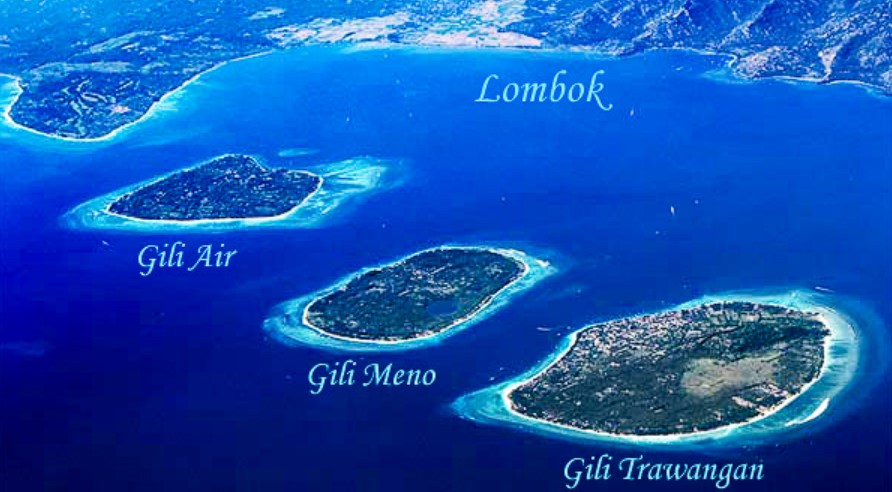
You can literally go swimming and snorkeling off the shore from anywhere in any of the Gili islands. The islands are home to coral reefs, colourful fish, small reef sharks, sea turtles, and even a few underwater statues. But be warned…there will be lots of people trampling and ruining the reefs. What was probably once an idyllic location is becoming increasingly ruined.
If you didn’t bring your own snorkeling gear, it’s easy to rent a mask, flippers, and a snorkel at any of the dive shops in town or even from locals on the beach.
Gili Trawangan
Getting here from Lombok was a simple car ride to the port and a few dollar (30 minute) boat ride across the water. We had the option of the fast boat or the local boat. The fast boat ($8.50) left on the hour every hour and took 20 minutes while the local boat was cheaper (about $2.25) and had a more laissez-faire timetable. Being in no particular rush, and having just missed the 11am fast boat, we opted for the local boat.
This had multiple benefits, the boat left when it was full (which happened every 20-30 minutes or so) so we were on Gili T before the fast boat was even due to leave.
The local boat drops you on the beach, away from the dock, so you also avoided having to pay the island tax ($2) on arrival.
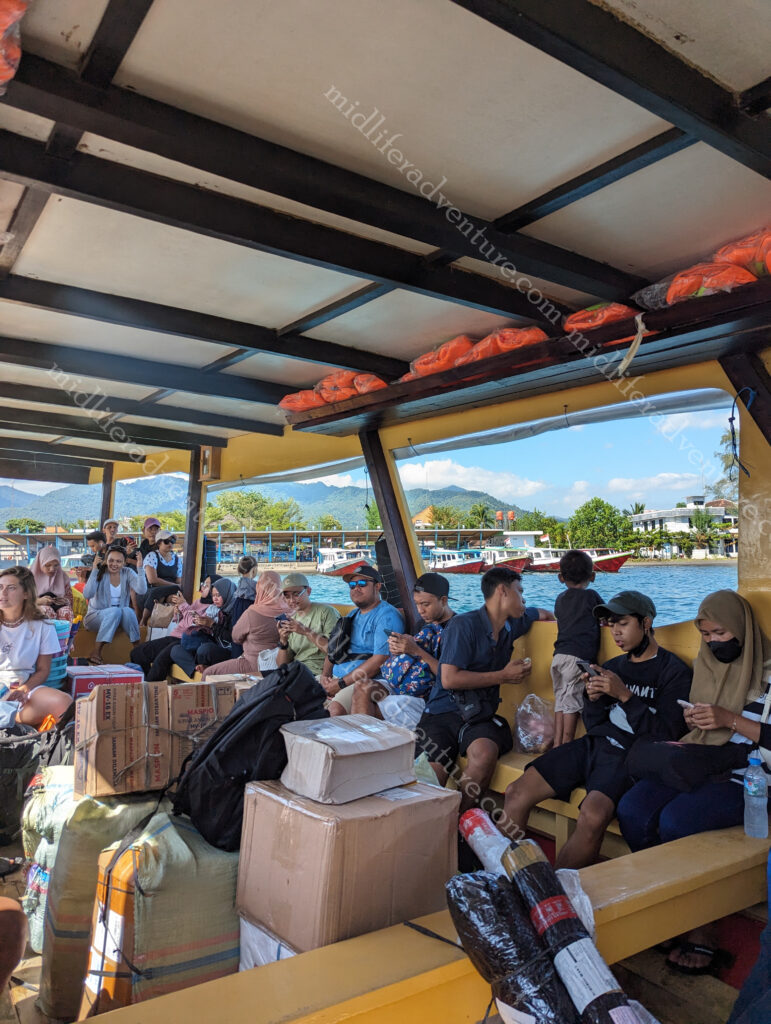
Gili Trawangan is where we stayed, it is the more developed of the islands with a buzzing beach strip, bars and restaurants and is the launching point for most of the tours, ferries and day trips.
The island is about 3 km long and 2 km wide with a permanent population of around 1500 and at least that much again (if not much more) in daily tourist influx.
On Gili Trawangan (as well as the other two Gilis), there are no motorised vehicles.
The main means of transportation are bicycles (rented by locals to tourists) and cidomo (a small horse-drawn carriage).
For travelling to and from each of the Gilis, locals usually use motorised boats and speedboats.
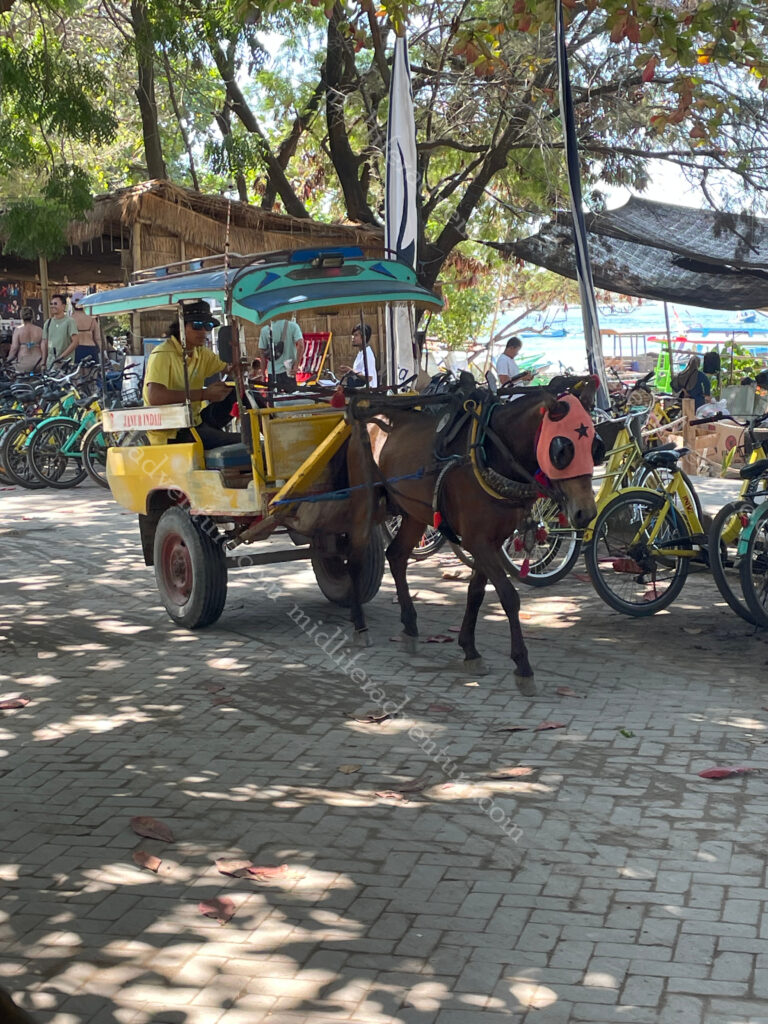
Most people rent bicycles to get around. There is only one main road on the island so if you just follow the road, you will ring the island within about an hour. You can rent a bicycle for $5 a day or $1.50 an hour. But beware, there are many uncoordinated and not road wise people who also rent them who are a danger to themselves and others. Not to mention many pedestrians with their heads up their ass.
A short walk to the hotel, get settled, a swim, line up our snorkelling adventures for the next day and find a sport for dinner. And what a spot we found. Feet in the sand, sunset views, cheap food, great service, daily catch seafood, western and local menu, reasonably priced beer and 3 cocktails for $10. We ended up eating here all 3 nights.







Gili Trawangan has had a reputation since the 1980s as a location where magic (Psilocybin) mushrooms are openly advertised and sold. Police presence is low and within the last 10 years finding drugs on Gili Meno and especially Gili Air has become very easy. On Gili Air intense psychedelics are being sold openly to tourists for beach parties. While the police presence is low, Indonesian drug laws remain extremely harsh. Drug possession and use is prohibited and carries potentially grave risk (up to and including the death penalty).
There are several beaches in Gili Trawangan, all offering epic views, perfect swimming conditions, and plenty of beachside stalls, restaurants, and bars where you can grab a bite or enjoy a freshly cracked coconut.
Gili Meno
Gili Meno is the quietest of the Gilis and is mostly for couples and honeymooners. It has a few stylish boutique resorts (read expensive… comparatively) that are favoured by couples seeking an idyllic escape on pristine beaches. It has virtually no nightlife and very few restaurants (that are not attached to the resort).


The main attraction of Gili Meno is the sunken statue sculpture that sits just off the beach.
It was commissioned by the local eco-resort and was created by British sculptor, Jason deCaires Taylor. It consists of 48 life-size statues, formed into a circle. Embracing figures surround curled up statues on the ocean floor. It has become a must do stop for Instagrammers and punters alike, all seeking photos like the one above.
But the reality is quite different. Every boat, every snorkelling tour will take you here, typically all at the same time so rather than getting this view, you are fighting about 150-500 of your closest friends to get your idyllic photo.
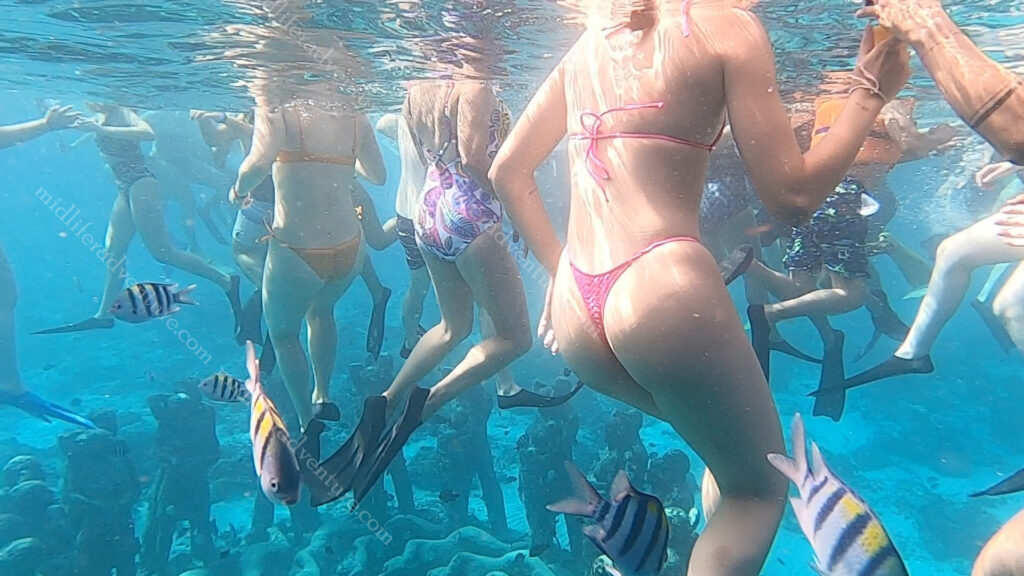
The next stop was onto the beach where you find yourself at the turtle sanctuary. This is where you get to see the tiny turtles that had the eggs saved from predators (ghost crabs, dogs, cats monitor lizards, foxes, monkeys etc.) were hatched and raised for 1 year until they are strong enough to be released.



From here it is off to turtle point, where you are virtually assured to see and swim with turtles. But much like the statues, there are several boat loads of people all stalking the same few turtles that are just trying to get a feed. So you are met with the bizarre circumstance of about 100 people in the water chasing after some poor unsuspecting turtles. But that said, you can get some great photos and while we were there, nobody tried to harass or touch the turtles.








Gili Air
Gili Air is the smallest of the islands and is the closest to Lombok, it has a few bars and a bit of accommodation, but on a much more affordable and laid back style than the other two islands. It is the only island in the Gili islands that has its own water table which it can draw fresh water from.
Gili Air has the best of (least trampled) the snorkelling and some bits set up just for the Instagrammers (water swings etc).

Penida Island
Nusa Penida is a relatively undeveloped island south-east of mainland Bali. It is mostly a day trippers island, being only a short hop from both Bali and Lombok, You won’t find snazzy beach clubs, organic cafes or trendy restaurants here, but Nusa Penida is still worthy of a visit. It houses some of the most photogenic sights in Bali.
The main reason people (Instagrammers) come is to get a photo with the rocky outcrop shaped like a T-Rex. The island scenery is pretty spectacular with some pretty amazing cliffs and beaches, but you do need to work to get to them.



If you spend the night on the island this is easy as you can go early in the morning, before the day trippers arrive. But if you sleep in it quickly becomes a nightmare. The first of the ferries and fast boats tend to leave at around 8am so by 8:30 the hordes are arriving. The roads on the island are single lane and full of potholes. Everyone is going to the same places and you end up in a line of traffic and then a line of people all looking for the same photograph.



The same then happens when it comes to lunch and snorkelling, before they all fight for the jetty and dock to go back to either Bali or Lombok. The best way is to arrive mid-late morning with the intent of spending the night and do the tour in the afternoon while the day trippers are all scrambling home. Then you can have a leisurely breakfast the next day and leave on one of the many departing fast boats.
Sanur
Having arrived at Sanur in Bali it was a simple (eventually) matter of getting a Grab and heading to the boy’s place. I say eventually as the taxi industry had taken over the port and had banned all ride share companies access. This meant that you had to schlepp it out of the port for about 1.5 km before the Grab driver could pick you up.
This was not really the issue. The main issue is that you get set upon every step of the way by some of the most aggressive and pushy touts that we have come across in some time.
Anyway, we made it back for some kick back for a few days before launching on our next round of island hopping.
Raja Ampat
t big adventure was to visit an area known as Raja Ampat. We had never really heard of it before, but in speaking with some of the Indonesian staff on cruise ships they mentioned that it was amazing and should not be missed. So we did some googling and found it to be one of the last (relatively) untouched wildernesses left on the planet.

But we were later to find out that ‘relatively untouched wildernesses’ meant that, for the most part, there was bugger all here other than wildernesses. This was not a major issue but it did mean that everything was an effort, involved great expense, or once you got there you found very little (except for the natural beauty).
The research also told us that the area was highlighted on the Indonesian 100,000 rupiah ($10) note. Our experience in China suggested that if it was good enough to be on the note, then it was probably pretty good.
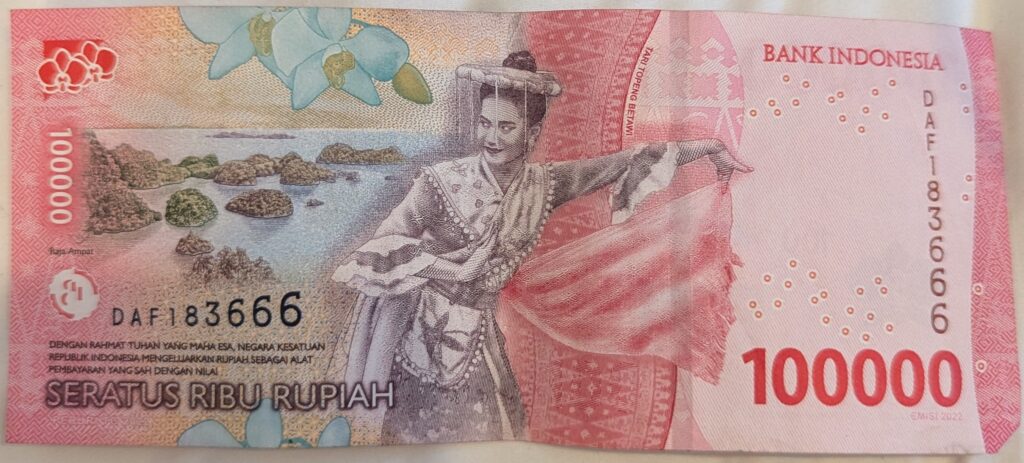
So it was decided then, but getting to the Raja Ampat Islands is not so simple sadly. They are in the easternmost part of Indonesia and the westernmost part of Papua. They stretch over around 4.6 million hectares and consist of 4 large islands, (Waigeo, Batanta, Salawati and Misool) along with another 1,847 other smaller islands.
Our journey to get to Raja Ampat started in Bali at midnight with a taxi ride to the airport, to check in to our 2:15am flight to the town of Sorong in Western Papua. Landing at 6am it was then in a cab (read bongo van) to the port where we would hang about for the next 2 hours waiting for the port staff to arrive (bear in mind, island time seriously applies here). Once they got to work (15 minutes late) the next 15 minutes were spent waiting for the systems to wake up. Then at 8:30 the ticketing for the 9am ferry could commence.
At this point, the hundreds of people who had surged to line up (about 40 minutes earlier, prepping for the 8am opening) started to get pissed as the, just arriving, locals yelled their order from the back and got served, ahead of all those who had (like us) been waiting the preceding two and a half hours. Add to this those that just pushed their way to the front of the queue and tempers were flaring as the ever ticking clock kept marching forward as did the looming boat departure. If you miss this boat, you have another 6 hour wait to get onto the next one.
The first thing that strikes you is that this area is much more like PNG than it is like Indonesia. The faces of the people have changed from the more typical Asian to a greater prevalence of Melanesian features. The forests also seem denser and more fearsome than the ones on the other Indonesian islands.

The name Raja Ampat (the Four Kings) itself is believed to come from a local legend that claimed that long ago there was a woman who found seven eggs, four of which hatched into kings who ruled the four main islands. There are three others left, one is a rock, one is a woman, and the other is a supernatural creature or ghost.
According to the experts, Raja Ampat is an area with the healthiest reefs found almost anywhere on the planet. The reefs host hundreds of species of marine life as well as the passing currents bringing other migratory visitors. It is estimated that around 75% of all coral species in the world can be found here (these photos are courtesy of the Blue Water Dive website).




Waisai City
Once off our bout we found ourselves in Waisai City (township more like) which is on Waigeo Island. The town has a population of around 21,000 with most of these being from the indigenous Ma’ya , Biak , and Ondoloren tribes. Most of the indigenous people continue to live simple, traditional, subsistence lives with the main goal being to simply meet their daily needs.
This became very obvious when we ventured to town and to the markets for our tourist walkabout.
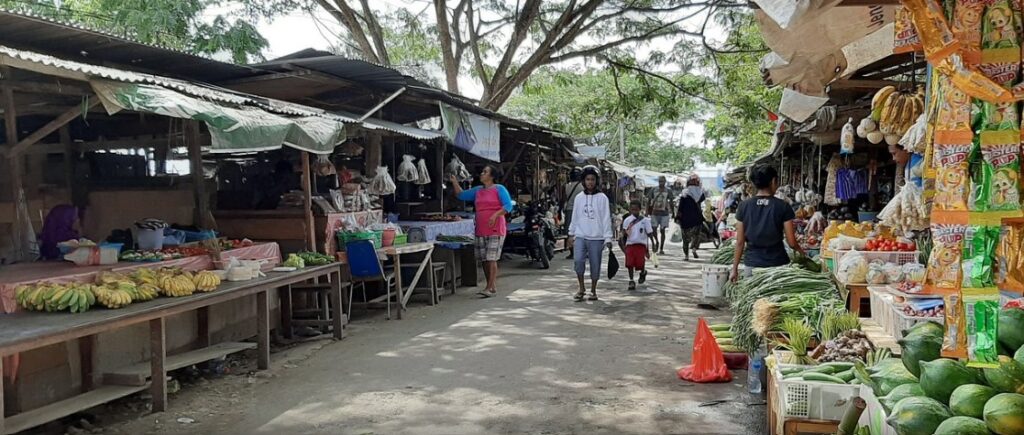
And this would be our home for the next 5 days. Well sort of. We were on an all inclusive resort a couple of kms out of town. The resort was about 3 times more expensive than we would normally pay but id did include full board (three meals a day), and quite frankly, everything over here is way more expensive than the rest of Indonesia.
The meals were all very nice, if a little limited in range. Every meal (except breakfast) was either chicken or seafood (fish, prawns or squid), served with a soup (potato, spinach, garlic or tofu) with sides of either tofu (various styles), tempeh (a soy bean paste style muesli bar thingy) and veg (typically bean or spinach). Don’t get me wrong, they were tasty, and it was all super fresh, but chicken and fish with rice and veg wears pretty thin.





The all inclusive food was an interesting concept for us, but that is the way things go out here. There are virtually no restaurants, certainly no food delivery, and given we were a few kilometers out of town, very few options other than what they supplied. It was all absolutely fresh and totally seasonal.
Our hotel sat on the edge of a mangrove. There was a wooden jetty that took you through (over) the mangrove out onto your own private jetty and coral garden. At low tide the low lying sea grass was largely exposed with the coral barely covered, but at high tide the reef was blooming with life.







The ringed Jetty was the first stage in what I am sure would end up to be a bunch of over water villas (as they were a couple of doors down). Just to the right of the dock was a field of sea grass that (we were told) was the favoured grazing area (if the tides are right) for our own personal dugongs (or manatees if you prefer). The owner said the dugongs like to feed at high sun (around noon).




Sadly we were unlucky with the timing and (while we were there) the noon tide was low, meaning that there was no swimming with manatees for me. While we did not get to swim with the dugongs, our private coral garden was teeming with fish, and had some of the healthiest soft coral we had ever seen. Typically you can still see nice hard coral, but clumsy tourists with fins tend to destroy the soft corals. The only place we have seen better was on the Great Barrier Reef.








Our reef had regular visits from stingrays, a semi-resident turtle and the odd appearance by baby reef sharks. All of this along with a bunch of tropical fish. Our dock was lovely and became our sunset beer location, with Jill typically dangling her feet in the water.
The hotel owner was apparently approached one day by local fishermen trying to sell giant clams. the owner asked what they do with them (the response being cook and eat them). So the owner bought the giant clam (at an exorbitant price), and directed them to put it back in the water as the Center-point of their private reef. Today, there are several smaller ones that have also taken up residence (not really too sure on the breeding or migration habits of giant clams) but at the moment there at least six of them at varying sizes.
WTC Beach
Right in the heart of Waisai township you will find the Waisai Torang Cinta Beach, which is now commonly known as WTC Beach. It used to be called Beloved Waisai Beach but the first governor of West Papua Province, (how cool is this name) Abraham Ocktavianu Atururi, officially changed it.
It has had a grand entrance built, replete with matching dolphin fountains (empty), but there is no real beach, just a rock wall and general community meeting point.
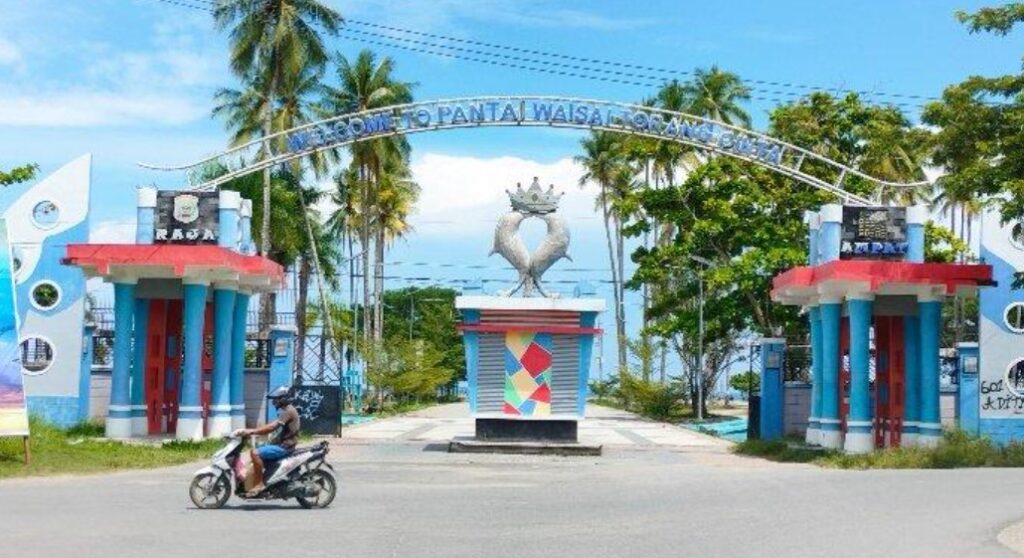
The park itself is in a pretty poor state of disrepair but a lot of effort has been put into developing the surrounds (maybe some effort is needed in the upkeep). The park, if tidied up, could be nice with paved walkways and heaps of coconut trees. It is now more a local fishing spot with many fish regularly caught straight off the rocks.
The main event
Having enjoyed the area we bit the bullet and paid the (comparatively) exorbitant price tag to go and see the Raja Ampat lagoon that was the subject of all of the tourist photos. When we took off at Gili Trawangan for a 6 hour snorkelling and sightseeing tour our bill was 200,000 ($20) a head. But here it was 1.85 million ($185 each) for the same duration with fewer stops.
The planned day took in the Star Lagoon, Manta Lagoon, and the main attraction of Painemo Lagoon. Add to this some snorkelling and a sand bar and the day was complete. The start was not auspicious when we got to the dock and the engines were in pieces while the mechanic feverishly worked away. We were told that it was just a fuel filter change and that all would be good.
Star(Bintang) Lagoon
The first port of call for us was to the Star Lagoon (Bintang along with being the local beer is the Indonesian word for star). As the name suggests, it is a lagoon shaped like a star, that is filled with amazing green water. the dock is low and to get the full effect of the star, you have to hike up to the top of the hill along the sketchiest path that has existed, made of rugged and jagged coral.







I started to climb the stairs and quickly decided that this was not for me. Sharp jagged rocks and step widths of less than 2 inches were enough for me to know that my size 11-12 feet would not fit with this scaling well at all. Jill on the other hand, intrepidly boxed on. She came back down claiming that there was no way that I could have made it as the path (and stairs) got considerably worse and sketchier the higher you went.
Manta Lagoon
Having checked out Star Lagoon, it was on to Manta Lagoon next. Sadly the lagoon is named this way due to its shape and not because of an abundance of Manta Rays (although there are such areas in the region). If the first set of stairs was sketchy, then this one took the cake.
These were man made wooden stairs and the guide forbade us from even attempting the stairs. He had a very long and earnest conversation at just how dangerous these particular stairs were, and how they could not be trusted.






We looked up and saw the platform at the top (giving the Manta shaped view) and decided that there was no way that we were going to trust the West Papuan engineering standards. Rotten boards were clearly visible and the viewing platform was nothing even resembling sound.
Painemo Lagoon
Next stop the main attraction, Painemo Lagoon. This too had a ridiculous climb to get to the top (300 stairs each way) but the quality of the stairs and platforms were good. They were sturdy, secure, and were built of railway style sleepers that were thick and well made. But they still required some serious climbing.




But having made the effort, the pay-off was definitely worth it. The view was exactly as promised, breathtaking (maybe it was the stairs). This really was something very special.







It has been estimated that there are 1,318 different types of fish, 699 types of mollusks (soft animals), and 537 types of coral reefs in and around the Raja Ampat Region. Having ticked the magic view box, it was time to explore the reefs and wildlife (more broadly than our own private coral garden). So the next stop was at another small island for some snorkelling amid the most amazing array of fish that we have seen in decades.








There were so many fish, so many colours and of sizes that guaranteed you an amazing experience. Raja Ampat really was delivering.
Our final port of call before heading home again, was to a sandbar that pops up at the right time of the tidal flow. Crystal clear waters, white sand, seriously…what more could you want. Add to that a guide with a drone to get aerial images of you lazing in the water (and some stupid group shots).



Tour over, it was back to our hotel for a couple of more days kicking back and enjoying our private coral garden and reef. According to the owner, about 50 meters past the jetty was a major drop-off with even more coral and fish species. Jill and I went a couple of times, but neither of us felt comfortable enough with the tides and currents to brave exploring this.
Sorong
While Sorong was our entry point, we didn’t get time to explore it (other than the port) until at the end when we had some spare time on our way out. Sorong City was settled by the Dutch in West Papua to support their oil operations. The city is known as the City of Oil as it was the home of Dutch oil activities since the 1930’s. Sorong is the largest city in West Papua Province and the second largest city in Papuan Indonesia, after Jayapura City.
The area is inhabited (mostly) by the indigenous Moi tribe which are one of the Papuan tribes inhabiting most of Sorong district, Sorong city and the Southwest Papua province.

The Moi tribe have a traditional territory spanning about 400 thousand hectares of land. The people believe that the forests and humans are inseparable, and depend on forests for food and other resources to meet their families’ economic needs. The tribe has a distinct forest management strategy that is clearly defined and mapped, to minimise inter clan conflicts.
This forest management sophistication has brought the tribe into conflict with the central Indonesian Government who has authorised logging increases at odds with the tribal management. The central government policy is at odds with Egek which is a cultural heritage passed down from generation to generation. Egek aims to provide an opportunity for nature to renew and restore before its resources are processed again to meet people’s needs. Philosophically, the Moi tribe recognises that forests and land are a lifeline.
The remainder of the inhabitants are from all over the region who have migrated to the area for a simpler life.
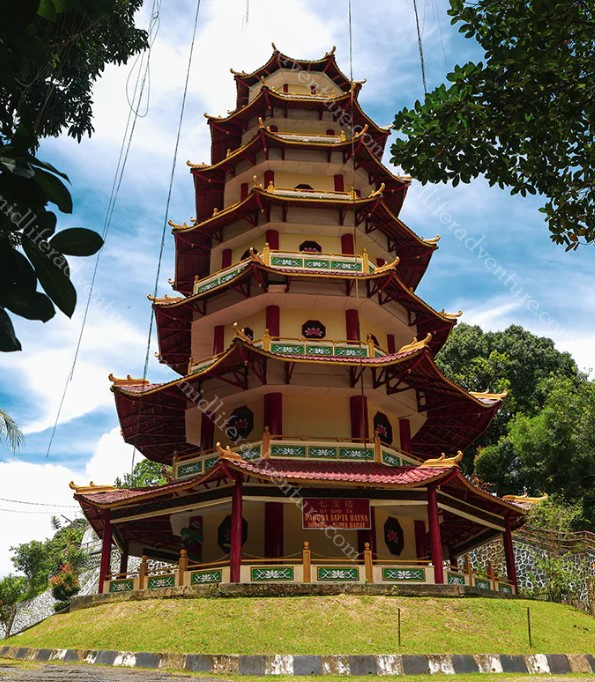
Sapta Ratna Pagoda is a Chinese Buddhist style temple built about twenty-five years ago.
The Pagoda is a 7 tiered structure that can be visited for about a buck.
Puri Bridge Fish Market is one for the early risers. A small harbor with that morning’s catch, no ice, no stalls just fresh fish on blue tarpaulins.
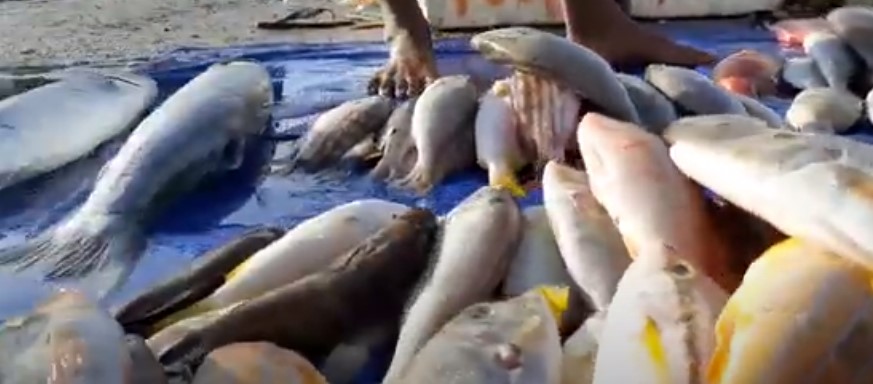
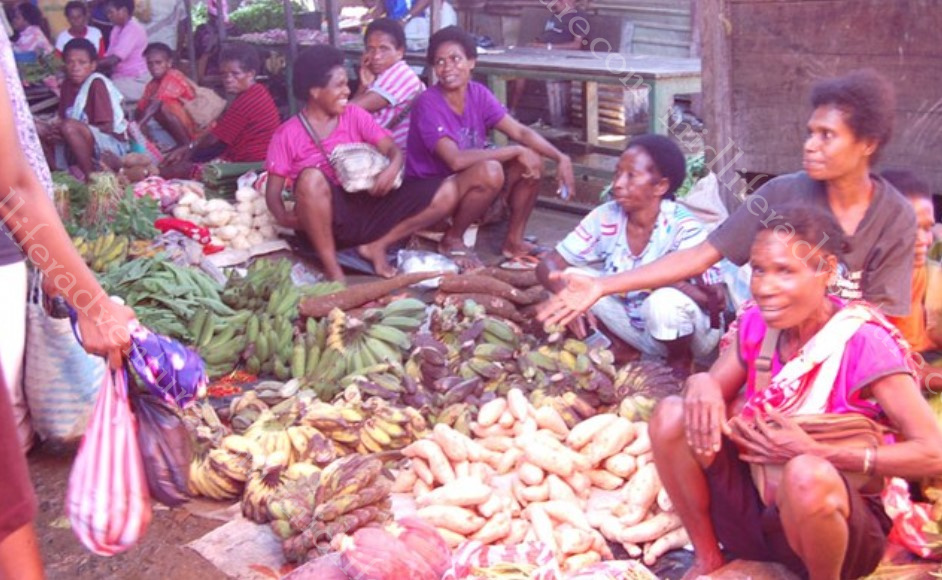
Remu Market was around the corner from our hotel, near the airport. It is the main market in Sarong and is full all day every day. A combination wet market and everyday goods.
If the markets in Waisai were basic, then these ones in Sorong were much worse. The town is on the fringe of a tropical rainforest and gets the rainfall that goes with it. While we were there it rained almost non-stop. When it does, the dirt floors and streets turn into either muddy messes or straight out puddles.
Thankfully we found an actual shopping mall and managed to avoid this mess entirely. Surprisingly, the quality of the products and produce in the indoor mall was top notch.
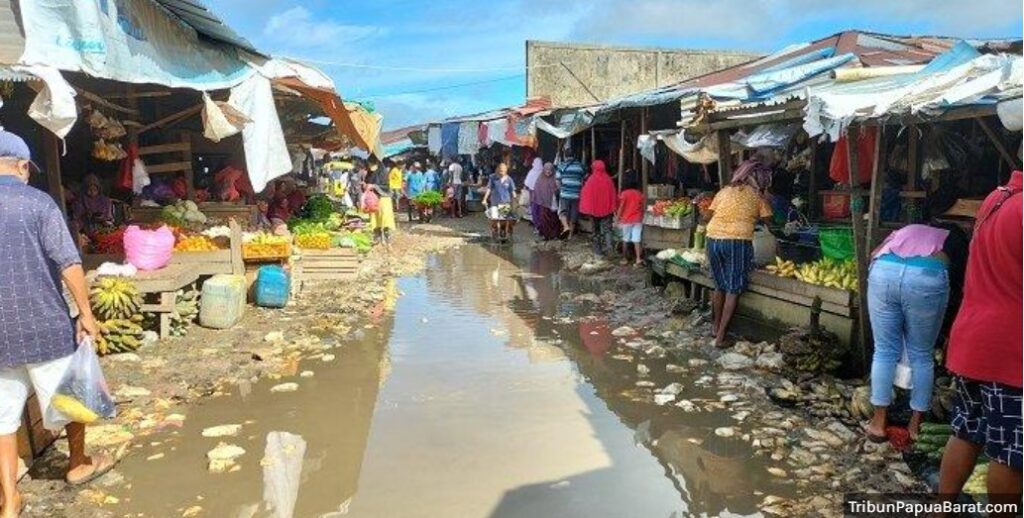
In reality, Sorong is as close to a shithole as you will find. Open drains, rubbish everywhere and just a generally primitive and run down location. Apart from being the launching point for something truly amazing, there is very little to recommend the place. The people we came across were happy and friendly, but the approach to rubbish and burning of trash was quite frankly atrocious.
Next time – Liveaboard Cruising
While we really enjoyed our time here in Raja Ampat and it was amazing to see and experience, I’m not entirely sure that we did it the right way. There are a bunch of liveaboard cruises setting out from Bali and Sarong that do 3-7 day explorations of the area on small four room yachts. These are run by any number of dive companies and offer incredible package deals.









It will cost a lot of money but they really look like the best way to get a sampler of the area (without the primitive exposures that we caught). They take in everything that we saw and a whole lot more, the remove the dramas and they look really informative. There is even a Rolls Royce 12-14 day itinerary.
Many of these are specific to divers but a little bit of research and you can find one more for snorkelling and kayaking. Or if you a have always wanted to get your dive ticket, then there are combo offers where you can learn to dive at the same time. I think that a 3-4 day version of this would be about spot on.
eaving Sorong (thankfully), we hopped an early morning flight to Jakarta and than on again to Belitung. While it was just a transit we were struck with the ingenuity shown at Jakarta airport with their fire extinguishers. Rather that being necessary ugly lumps on the wall they have been painted in a way so as to simultaneously disguise them while at the same time highlighting their location.



Belitung
Beltung is an island north of Jakarta and off the east coast of Sumatra , Indonesia. It is famous for white pepper, seafood products and tin mining.
It is slowly becoming known as a natural tourism destination, particularly for its white sand beaches and granite boulders.
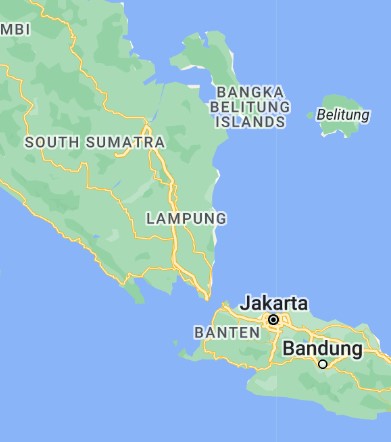
The first thing that struck us about Belitung was that the place was really clean. The telltale (Indonesian) rubbish was not everywhere, there were not burning piles of green waste polluting the air and the whole feel of the place was good. The roads are in great shape and compared to almost everywhere else, the traffic is surprisingly light.
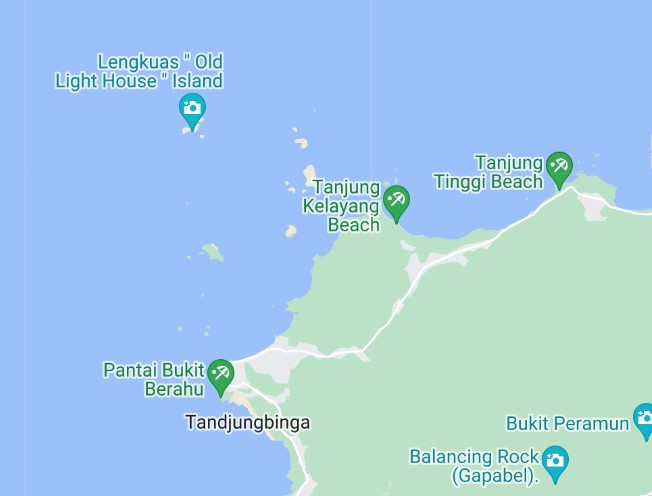
We either stayed too short or too long on the island, depending upon your point of view. It is a place that you can blitz in a day or two, or it is a place that you can kick back for a month.
When choosing location Jill picked the close to town (and food) option rather than the further away beach option. Our hotel was nice, right on the water with an infinity pool facing west. During low tide there was almost a kilometer of sand before you hit the water and at high tide you were surrounded. Facing west, the sunsets were pretty good.






There are not too many things to do in Belitung, with the majority being on the northern part of the island. It is surrounded by lots of tiny islands and granite rock formations. With such surrounds it has made it the perfect place to get in a boat and go island hopping, which was written up as by far the best thing to do.
With that as the benchmark, after a couple of days we signed up to do the day tour. The majority of these involve a pickup from and drop off to the airport or sometimes a hotel. This suggested that the island was a literal day trippers location from Jakarta (one hour flight). The itinerary of the tour was to include: Tanjung Kelayang Beach, Sand Island, Batu Berlayar Island, Lengkuas Island, Kelayang Island & Kelayang Cave, Tanjung Tinggi Beach.
Tanjung Kelayang Beach was the boat meeting and launching point.

Tanjung Kelayang also has the Tanjung Binga Fisherman’s Village nearby for those that want a taste of local traditional life. The beach itself was nice with the renowned granite boulders.





A short distance away you get to Garuda Island With the mythical bird shaped rock formation poking high above the others. Here it is a quick stop (for us at least) for some photos. The local tourists spent about three times as long making sure that they got their pictures.











Next was Batu Berlayar Island and this is when both Jill and I looked at each other and decided that this is where we should have stayed. Not the island, but on the mainland opposite. The stunning white sand beaches, turquoise water, rocky granite islands, underwater coral reefs, and even the Dutch lighthouse were all visible and it was amazing. Oh it was also the location of the big 5 star chain hotels, but there were a few cheapies interspersed in there for us.



Just off the beach (and not mentioned in the spiel) is the Lenkaus Island and the Old Indie Lighthouse. This is an old Dutch lighthouse dating back to the 1800’s.







After the lighthouse we had our obligatory snorkelling stop. The snorkeling was ok quality, however after Raja Ampat really did not compare. There was certainly lost of (hard) coral and small fish but the turtles, tropical fish and larger predators where nowhere to be seen. I did however manage to perfectly capture on film (above and below the water) exactly why the reefs of the world are in such a terrible state. It was a group of local tourists pausing for a selfie while standing directly on a live head of coral.




The next stop was to our lunch location on Kepayang Island. A nice (clean) sandy beach a restaurant in the sand and an included local lunch. A beautiful mix of prawn, crab, calamari, and grilled fish all served with steamed rice, grilled water spinach and a healthy amount of sambal and chilli on the side.






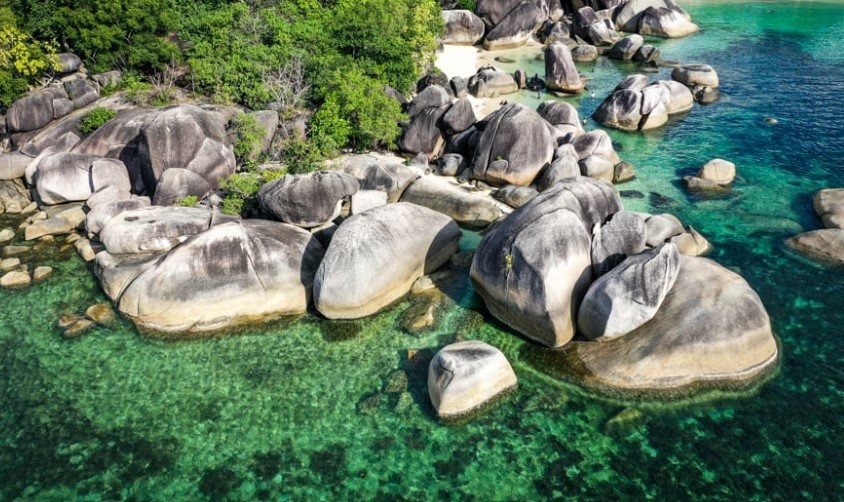
Last stop was possibly the most photogenic of the beaches in Belitung, Tanjung Tinggi Beach. It has perfect blue-green water and giant boulders.
Most of the clouds that had been stalking us all day had mostly burnt off and this was very clearly a beach for the locals. Tons of local restaurants, more inflatable animal floaties than I had seen in years and a nice, flat calm ocean.




But most importantly for us, they had beer. We had been dry for the preceding five days. On a local, Muslim island, beer can sometimes be a bit tough to find. Our hotel did sell them but at prices that exceeded what you would pay back home. So we stopped and had one and took a couple home. Oh the beach is a good sunset spot too.
The tourist walk to town was fairly uninspiring, with very little around to see or do. The roundabouts were a little entertaining, but for the most part we were just in a local community on an out of the way island.
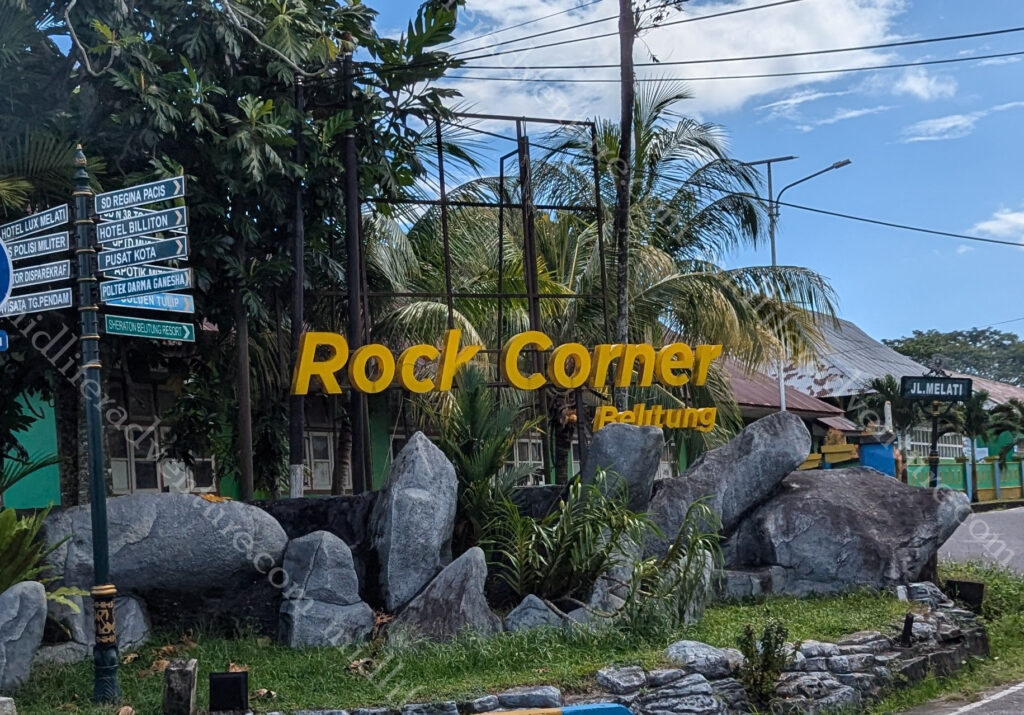
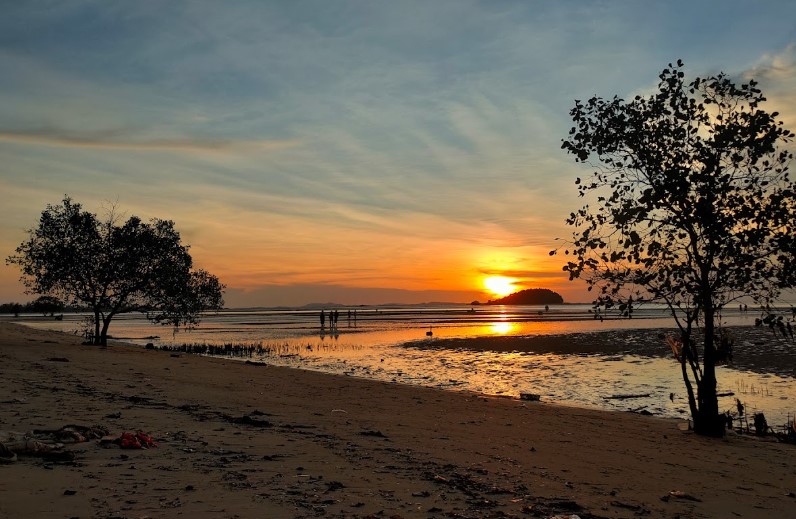
On our tourist wander we went past Pendam Beach which is the beach closest to the main town Tanjung Pandan. As a west facing beach it is popular as a spot to watch the sunset.
Penyabong Beach is a more secluded beach in the southwest about 1.5 hours from town. We did not make it but reports say that it has white sand and no crowds, but recent commentary indicate that trash has built up over the years.
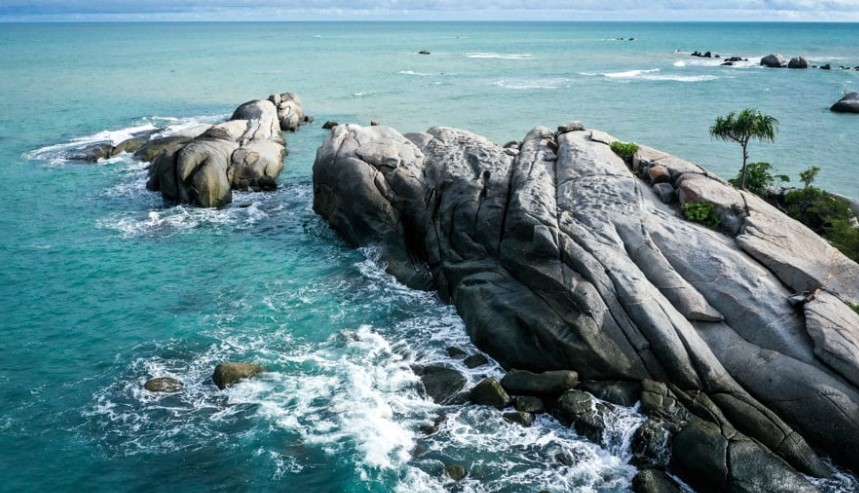
As I mentioned at the beginning, we either stayed too short or too long on the island. A short trip could be done and dusted in 2-3 days but we stayed six. This was mostly to avoid being in Yogyakarta (and the temples) on the busy weekend. But the island is nice, accommodation and food is very affordable and if we had stayed further north (which we would do next time) the access to beer is a little easier.






But paying local prices and staying close to the beach up north, could warrant a bit more time and some further exploration.
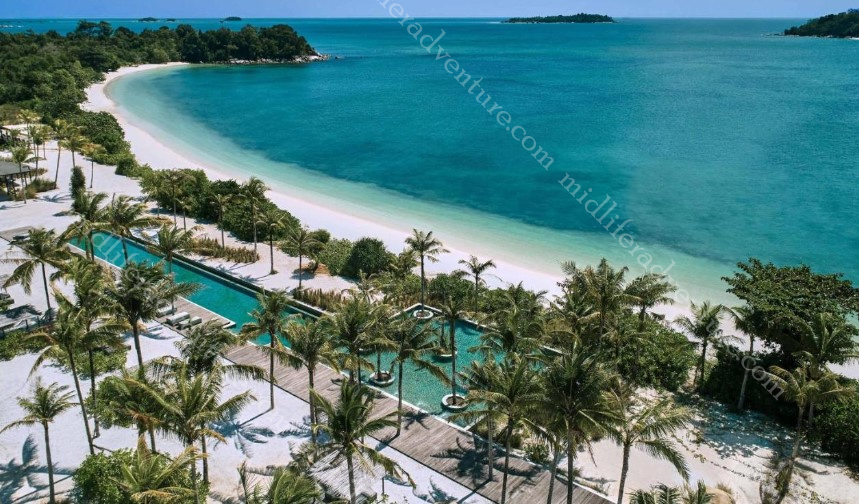
Yogyakarta
Yogyakarta is one of the foremost cultural centers of Indonesia it was the seat of power during the 8th and 9th century and was the driving force behind the creation of the temples of Boribudur and Prambanan. It is a city that maintains the traditional concepts of Javanese culture.
The town itself was nice. It was clean with plenty of food and drink options available. The sights around town were interesting enough, without being amazing. But the real attractions were just outside of town. While I say just outside 42 km (Borobudur) and 17 km (Prambanan) respectively. But these still take at least an hour and a half to two hours to drive to due to the terrible state of the traffic. Not the roads, they are fine, the traffic.
Prambanan Temple
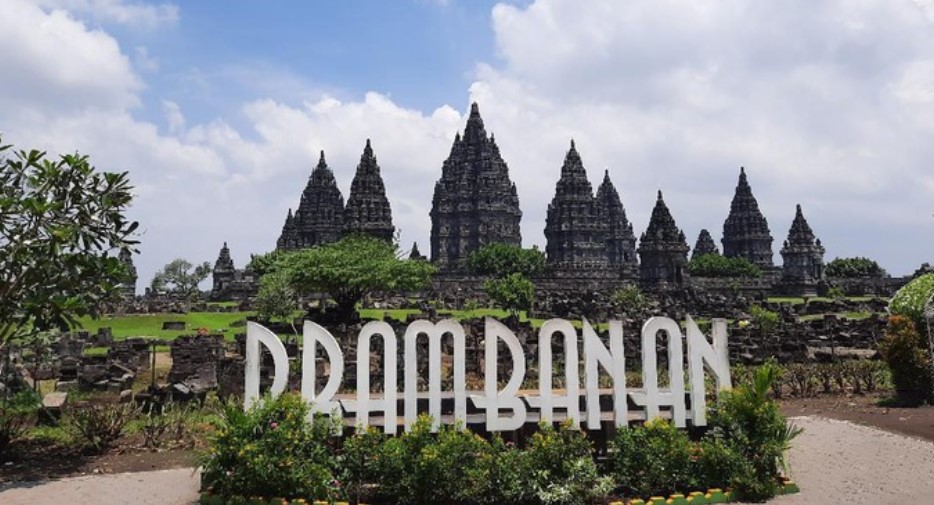
Prambanan Temple was our first port of call, it is the largest Hindu temple in Indonesia. It is not certain when this temple was built but it is thought that it was built around the middle of the 9th century by the king of the Sanjaya dynasty.
The complex is actually a series of four temples (Prambanan, Lumbung , Bubrah and Sewu) with the main one giving its name to the complex.
The original plan of Prambanan Temple was rectangular, consisting of an outer courtyard and three courtyards. The outer courtyard is oval in shape with an area of 390 sqm and was surrounded by a stone fence which is now in ruins.
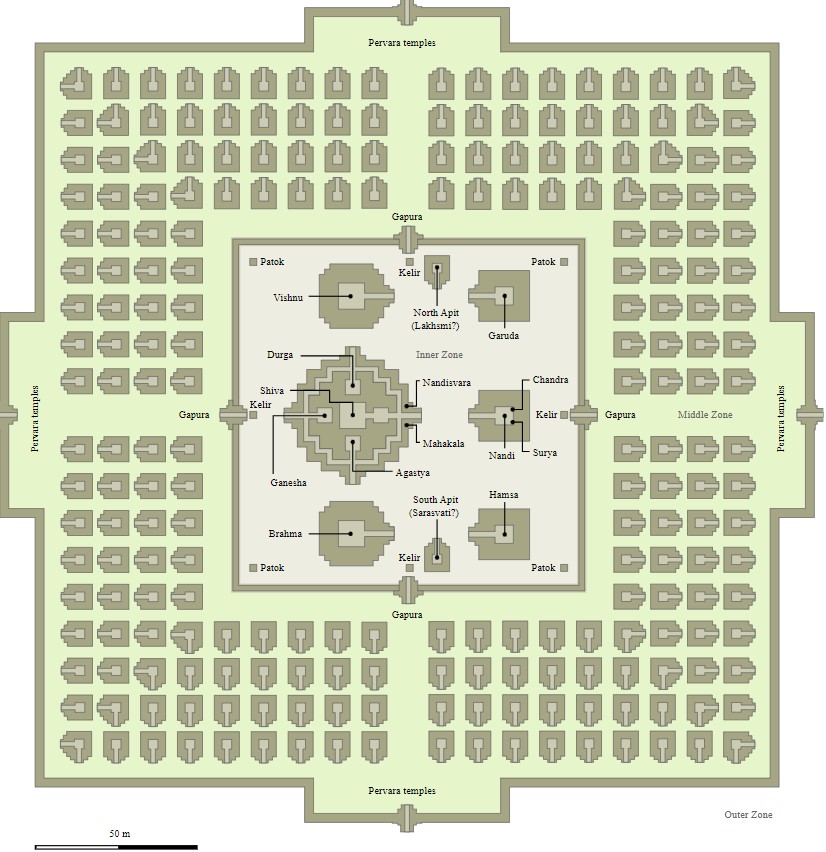



The second courtyard, is rectangular covering 222 m2. This courtyard consists of four terraces, with a total of 224 identical (6m square and 14m tall) temples. Almost all the temples in the central courtyard are currently in ruins.







The inner courtyard is considered the most sacred place it has a rectangular floor plan covering an area of 110 sqm. Three of the 8 main temples are called Trimurti (“three forms”) temples, dedicated to the 3 highest Hindu gods: God Brahma the Creator, Vishnu the Preserver, and Shiva the Destroyer (the biggest and central one).
In front of the Trimurti temple there are 3 smaller temples that have been dedicated to the transportation of the gods (the ox Nandi is Shiva’s vehicle, the swan is Brahma’s vehicle, and the Garuda is Vishnu’s vehicle).
At 3pm every day you are kicked out of the main temple (zone 1) but can hang out (in zone 2) for the next few hours. In the same complex as the Prambanan Temple you will also find the Lumbung , Bubrah and Sewu Temples (allegedly the best place for the sunset photos). Added to this is the Archaeological museum.




There has been a lot of effort that has gone into the restoration of these temples and the newer works are quite obvious (possibly even amusing). There has been an element of improvement as opposed to restoration that has been taking place.






In reality it was only the western tourists that ventured beyond the main temple (on foot anyway). The local tourists looked at Prambanan and the really adventurous ones caught an electric golf cart to Sewu and ignored the rest. It was only the few of us that hiked the whole complex and viewed each of the temples.
Borobudur
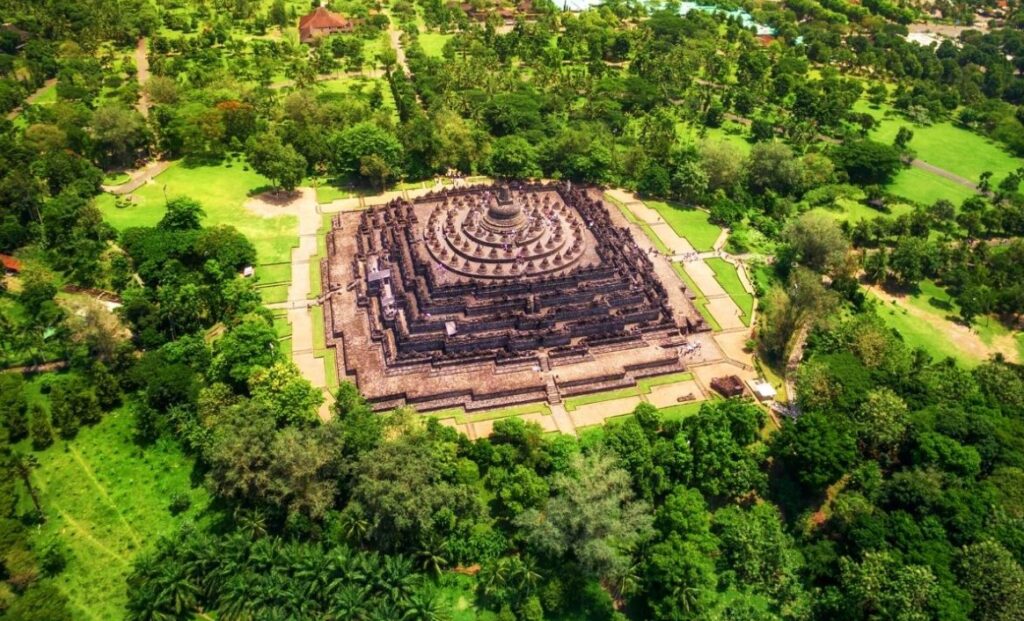
Borobudur is the largest Buddhist temple or shrine in the world, it was established in the ninth century and covers a square of 123 meters, with 9 platforms – the first six are square and the last 3 are circular.
In the 14th century, when Java’s population converted to Islam, the temple was abandoned and people forgot about it. In 1814, the British ruler of Java (Sir Thomas Stamford Raffles), re-discovered the temple with the help of a few locals. According to Buddhist teachings…this monument is a model of the universe and was built as a holy place to glorify Buddha as well as functioning as a place of pilgrimage to guide mankind from the realm of worldly desires to enlightenment and wisdom.







Borobudur built in the style of Mandala which symbolizes the universe in Buddhist teaching. This structure is square shaped with four entry points and a circular center point. Working from the outside in apparently the three zones of consciousness are represented, with the central sphere representing unconsciousness or Nirvana.




The temple walls are decorated with 2,672 relief panels and (originally) 504 Buddha statues, the largest and most complete collection of Buddhist reliefs in the world. The main stupa crowns the building and is surrounded by three circular rows of 72 perforated stupas (with a Buddha statue in lotus position in each).



As a tourist 400,000 ($40) rupees will get you in and the price for locals is 50,000 ($5). It is an extra $7.50 to climb to the top but be warned, these are bought out by the tour operators days in advance. They are available on the day but at full price (even if you have already bought the normal entry ticket on line).




Borobudur is on all a bunch of the bucket list items that generally surface. The spiels say that it ranks with Angkor Watt and Bagan as one of the great archaeological sites of Southeast Asia. Having been to all three, suffice to say that Jill and I were underwhelmed. It was ok but it was not worth the flights, accommodation, hellish car ride, high entrance costs and return journey. This will go in the OK been there done that category rather than the wow box.
Indonesian Food
same time. Initial impressions are amazing, but after a few days it all seems the same (Satay, Nasi Goreng and Mie Goreng). But if you persevere, it becomes really interesting again.
Satay is the first thing that you will likely find and fall in love with. Simple meat skewers, cooked over coals and served with a spicy peanut sauce poured all over the top.
It is a national dish conceived by street vendors and is practically everywhere but be warned, the quality varies dramatically.
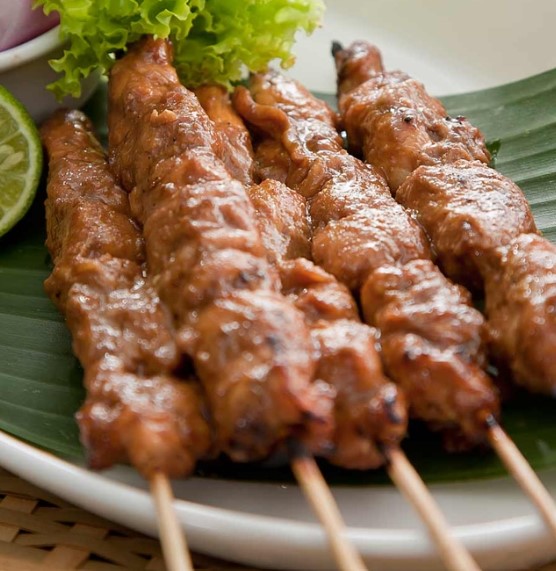
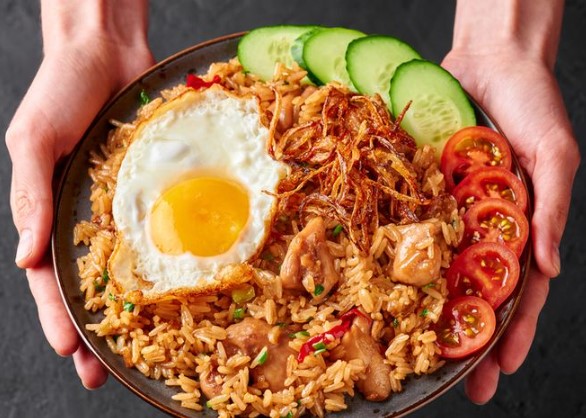
Nasi Goreng is a basic fried rice with a fried egg on top. A breakfast staple and perfectly acceptable.
Mie Goreng is identical to Nasi Goreng, but made with noodles instead.
Equally as tasty and equally ubiquitous.
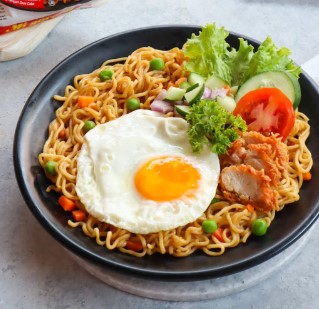

Siomay is Indonesia’s version of dim sum but nowhere near as good. This version contains steamed fish dumplings, with potato, cabbage, and egg, all served with peanut sauce.
Usually sold on the streets from a bicycle vendor with a large steamer at the back of his bike.
Gado Gado is a vegetable salad served with the magic peanut sauce.
Some come deconstructed and others come as a sticky mess. Most have boiled eggs and tempeh (fermented soy bean cake).

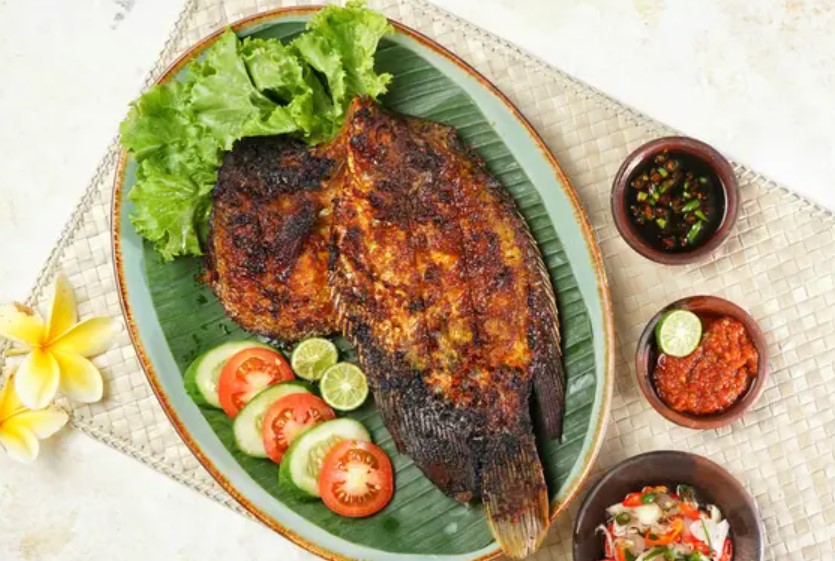
Ikan Bakar is everywhere. It is basically just grilled fish with a spicy marinade and an even spicier side sauce.
This is where many people run out, and while they are all fine, the Mie or Nasi Goreng breakfasts every day do tend to wear a bit thin. Indonesian food does typically tend to be quite spicy, so those seeking to lessen the chilli impact tend to settle for these safer choices. But if you box on and delve a little deeper into the cuisine, it gets interesting again.
Beef Rendang is ubiquitous throughout the region but originated in Sumatra, Indonesia (although my previous forays were always in Malaysia).
It is essentially beef, slow cooked in coconut milk with a bunch of chilli and spices.
And it is delicious.
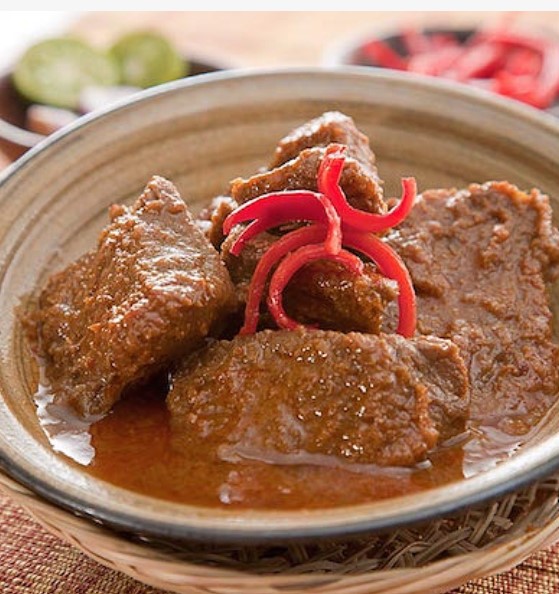
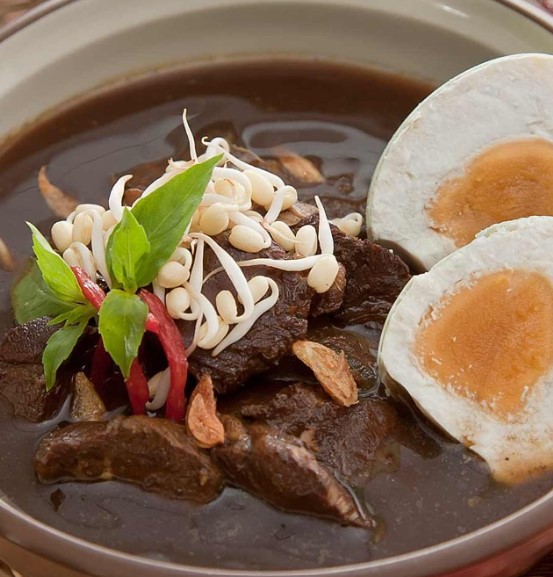
Nasi Rawon is a beef stew with a nutty flavour and a deep, black color from the use of keluak nut.
It is rich in flavor and is generally eaten with a bowl of rice (big surprise there).
Sop Buntut is basically just an oxtail soup.
The Indonesian version is as popular as ever and is a healthy and hearty soup.
The oxtail is usually fried or barbecued before being combined with the soup base.

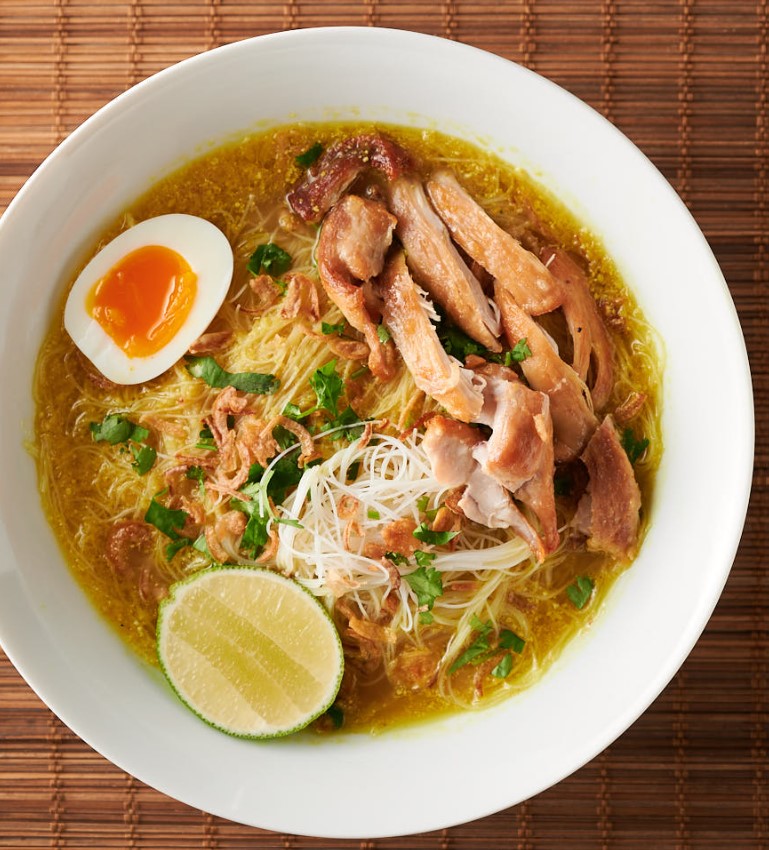
While on soups, the Soto Ayam is the local version of a basic Chicken soup.
Super simple and tasty and filled out with vermicelli noodles.
Bakso is the local meatball noodle soup.
Usually sold out of a pushcart on the street means that you can expect to get your fill for a couple of dollars.
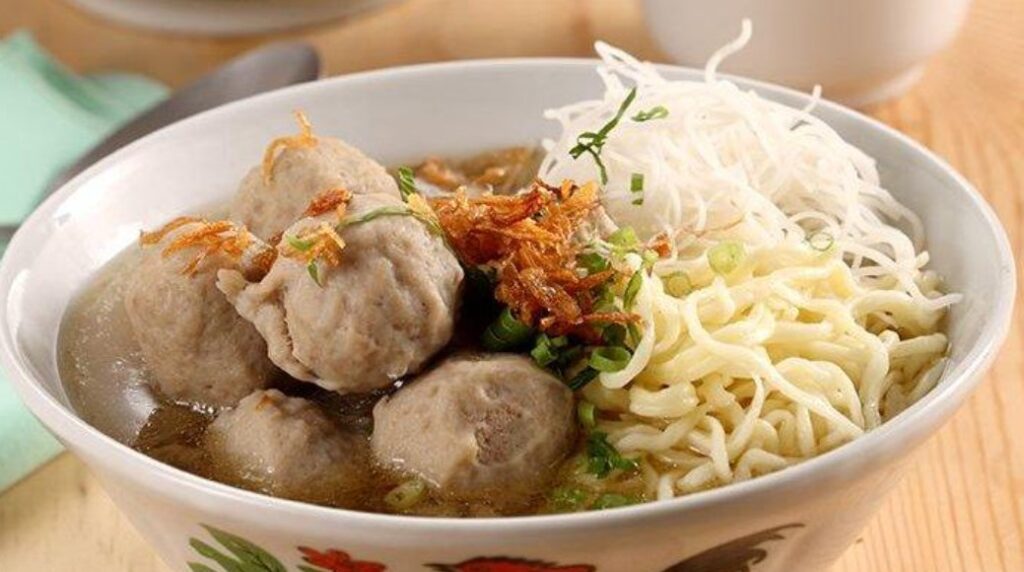
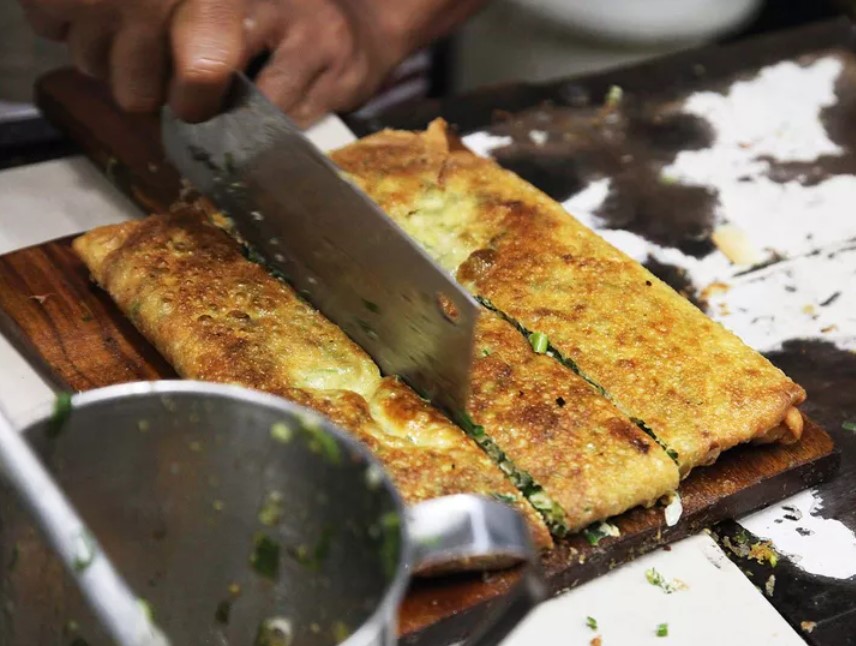
Martabak – in Indonesia, there are two types of martabak, namely salted/egg martabak which is made from a mixture of eggs and meat , and sweet martabak, which is usually filled with chocolate and goats cheese (Jill’s favourite).
Nasi campur literally just means mixed rice. But in Indonesia it refers to rice with a variety of Chinese meats like char siu, pork belly, roast chicken, or egg, all served with sweet tangy sauce.
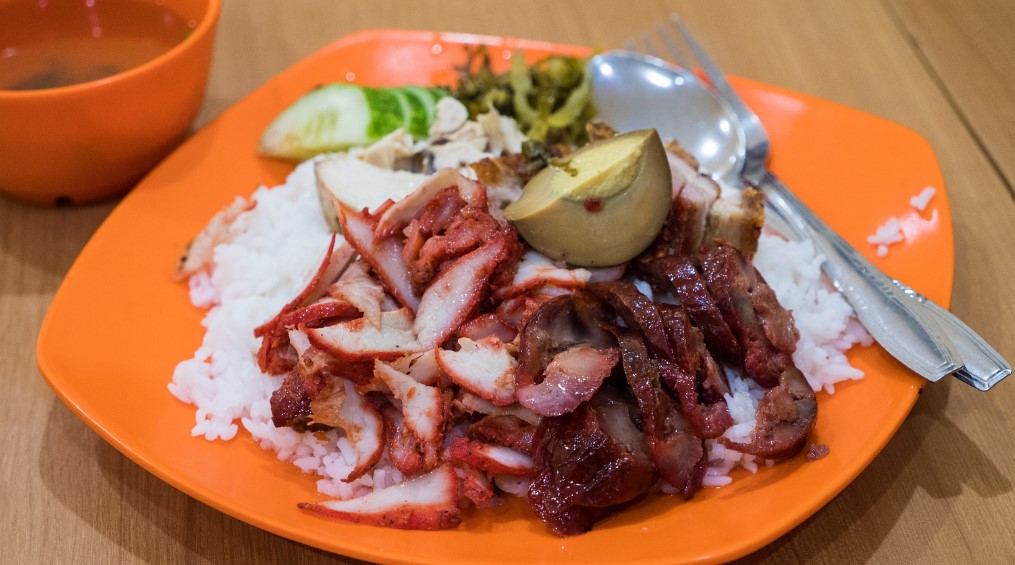
Typical side dishes
Sambal, this is on every plate, all the time, Tempe is next and has already been mentioned, the next most obvious is the water spinach that accompanies almost everything, Singkong (chips made of Cassava rather than potato). Acar is a mixed vegetable pickle (cabbage, carrots or beans, shallots that are heavily spiced with chilis), Krupuk is the prawn cracker type thing that you are used to, Lemang is a coconut sticky rice (typically cooked in bamboo over fire).





And of course my favourite, Belado (a spicy blend of ground red chilies, shallots or onions, garlic, tomato, tamarind, sugar, and salt). Belado means hot and spicy. Usually served on eggs as Telur Belado but also smeared on almost everything (the crispy tempe was particularly good). This became my regular daily breakfast.
A long story short, if you cannot find a great meal in Indonesia, you are not trying. Everything is easily available from your local Warung (roadside stall) and you will pay very little for it. But if you really need to eat what you know, then (as long as you stay on the beaten path) there are western options everywhere you look in the tourist hubs. These quickly disappear once you get off the beaten path though.